SCIOS
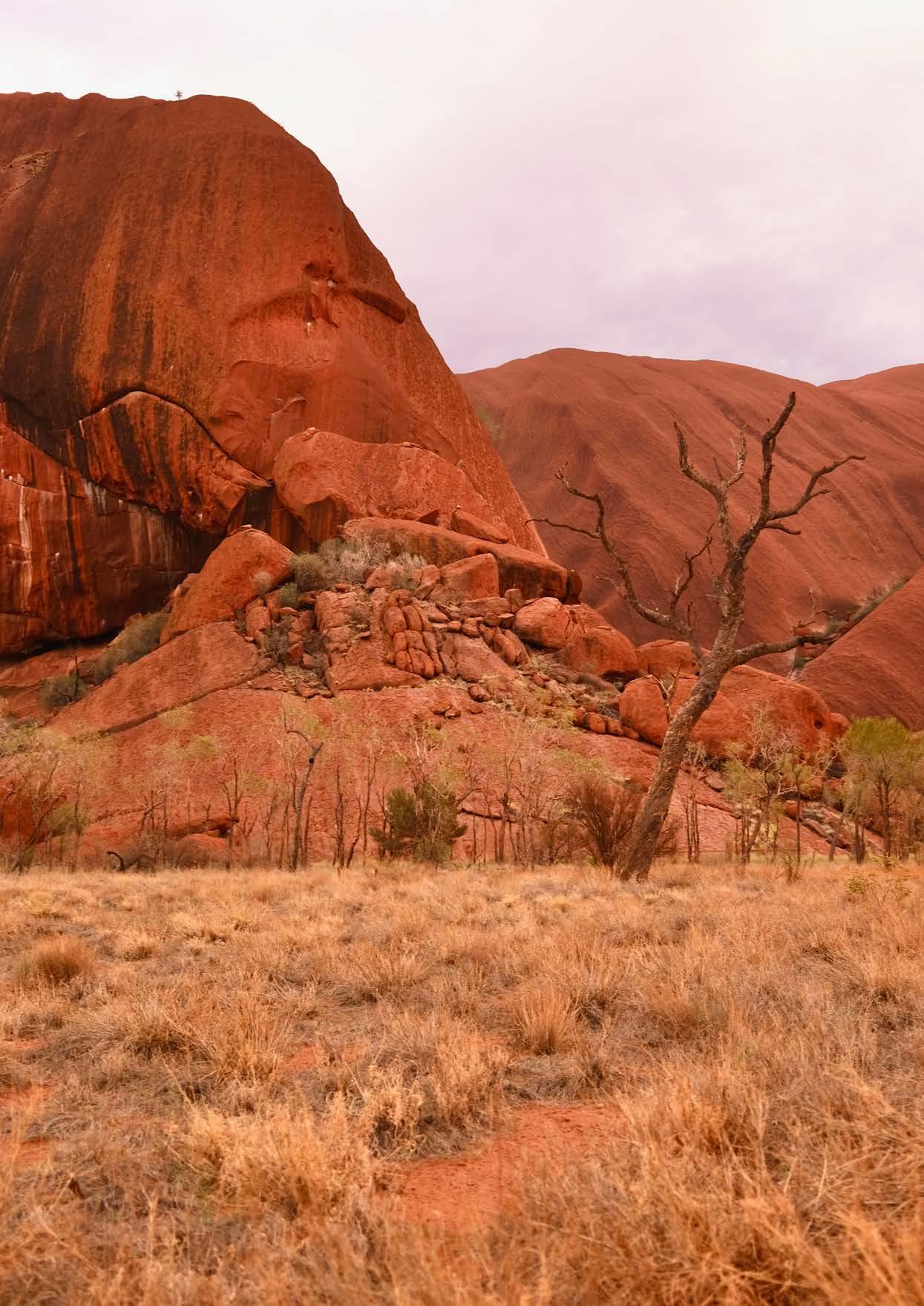
JOURNAL OF THE SCIENCE TEACHERS’ ASSOCIATION OF WESTERN AUSTRALIA VOLUME 68 DECEMBER 2022
working along-side top research scientists in some of Australia’s wildest places
SCIOS: To Know
This journal aims to promote the teaching of science with a focus on classroom practice. It provides a means of communication between teachers, consultants and other science educators. Opinions expressed in this publication are those of the various authors and do not necessarily represent those of The Science Teachers’ Association of Western Australia (STAWA), the editorial committee or the publisher.
STAWA Office
Unit 6, 10 Mallard Way, Cannington WA 6107
Contact
Tel +61 (0) 8 9244 1987 Fax +61 (0) 8 9244 2601 Email info@stawa.net.au Web www.stawa.net.au
Editorial Committee
Susan Doncon
Christine Howitt John Clarke - STAWA Siew Fong Yap
Lyndon Smith
Editorial Correspondence info@stawa.net.au
Graphic Designer
Kattie Muir - Digital Crayon
Advertising Enquiries
Tel +61 (0) 8 9244 1987 Fax +61 (0) 8 9244 2601 Email info@stawa.net
© 2022 The Science Teachers’ Association of Western Australia (STAWA). All rights reserved. No part of this publication may be reproduced or copied in any form or by any means without the written permission of STAWA. Unsolicited material is welcomed by the Editor but no responsibility is taken for the return of copy or photographs unless special arrangements are made.
ISSN 0157-6488
Cover Image photo by Kate Branch: https://www.pexels.com/ photo/leafless-tree-on-dry-land-10015974/
CONTENTS
Editorial
VOLUME 68 | DECEMBER 2022 JOURNAL OF THE SCIENCE TEACHERS’ ASSOCIATION OF WESTERN AUSTRALIA PAGE 2
3 5 7 9 13 14 16 18 24 27 31 36 37
From the President Chief Executive’s Report From the Archives CONSTAWA 41 WA Robotics Playoffs Showcases Young Technical Skills Building Barcoding to Save Biodiversity Bush Blitz Digging for Dinosaurs Creative Use of Classroom Space for a Primary Science Lab Science Week Made Easy STAWA Membership How to Contribute
As the year 2022 draws to a close, we heave with relief as the pandemic appears to have reined in. Looking retrospectively, the rapid development of highly effective vaccines against the COVID virus was a monumental achievement; yet it is concerning that there is still a fraction of the public rejecting this means of defence, resulting in far too many preventable deaths. As science educators, we need to consider if our science education is producing citizens who understand and respect scientific evidence and also necessitates a rethinking or refining of our science education learning outcomes.
The Australian curriculum strand, Science as a Human Endeavour, may incorporate creative ways of helping students develop an understanding of how reliable scientific knowledge accumulates, and devise ways to incorporate active learning and elements of studentdriven discovery. Through citizenship science, our
EDITORIAL
Dr. Siew Fong Yap
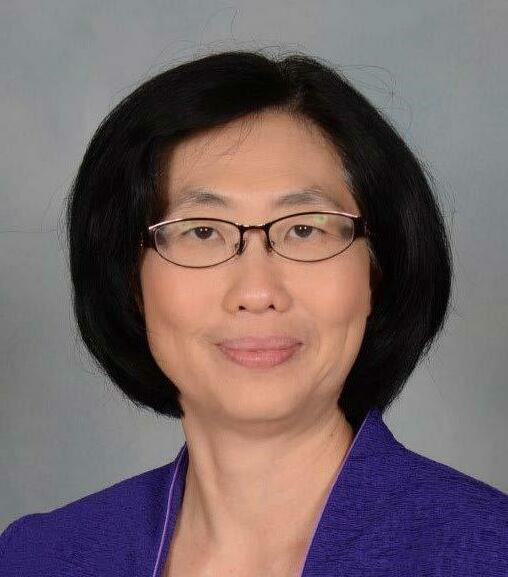
students can understand better how scientific truth is established and updated. It is based on verified and reproducible facts. The scientific method of gathering data, debating various formulations of the information, and arriving at consensus understandings of what is “true” about a particular matter has been the bedrock for establishing scientific truth for centuries. Cultivating our young minds with the rigour of the scientific method and understanding how truth is established and updated would contribute towards counteracting polarised public opinions, minimising the number of people led astray by disinformation, conspiracy theories and anti-science beliefs.
In this issue, we have several remarkable citizenship projects such as `Science in the Wild’ by Kerry Mazzotti where students and teachers can work alongside top research scientists on a biodiversity survey. This also include Bush Blitz TeachLive where teachers work alongside with scientists in remote Australian locations to share the knowledge on wildlife conservancy, biodiversity, and environmental conservation with the students. You will enjoy reading some of these fascinating accounts by Sarah Lacey and Emily Taylor. Promoting creativity and innovative thinking are also clearly evident in STEM-based tasks highlighted by Suzanne Hawkes in her article on WA Robotics competition.
PAGE 3 VOLUME 68 | DECEMBER 2022 JOURNAL OF THE SCIENCE TEACHERS’ ASSOCIATION OF WESTERN AUSTRALIA
helping students develop an understanding of how reliable scientific knowledge accumulates, and devise ways to incorporate active learning and elements of studentdriven discovery
Through the adept use of citizenship projects and innovative teaching, we can overcome the inertia that so often bound us to cling to the past instead of teaching to the future. Yes, imbued with such hope, we can effectively address the contemporary challenges such as climate change, food, energy, water security and deadly virus transmissions that can seriously impact local, regional, and global communities.
In closing this final issue as SCIO editor, I would like to acknowledge the indefatigable support of John Clarke, Annabel Kanakis and Kattie Muir. It has been a real privilege working with them to serve the community of science educators here in Western Australia. Special thanks are in place to all teachers who have worked extremely hard and made a real difference in the lives of our students through this somewhat disruptive and challenging year.
I wish everyone all the very best this festive season brings and may all be refreshed and recalibrated for the new year!
Dr Siew Fong Yap
About the editor
Dr Siew Fong Yap is the Head of Science at Perth’s Kingsway Christian College, a sessional teaching academic at Curtin University and Honorary Teaching Fellow of University of Western Australia. She is also part of the Oxford Science Curriculum Publishing team. She is on the Advisory Board of LASAR, Faculty of Arts, Humanities and Education, Canterbury Christ Church University, United Kingdom.
VOLUME 68 | DECEMBER 2022 JOURNAL OF THE SCIENCE TEACHERS’ ASSOCIATION OF WESTERN AUSTRALIA PAGE 4
Welcome to the December Issue of SCIOS.
I can’t believe that it is the end of the year already. Much has happened in the last few months. STAWA moved from the Cannington office to the Osborne Park office, and now Osborne Park has also been sold. We secured a storage space with office facilities near to the Osborne Park office and that will be our temporary home until Council has time to consider all options and move into fit for purpose premises at the beginning of 2023. We have two new staff members who will help STAWA move forward providing members with quality service and resources. Angie James-Wallace joined us as our Office Manager, working 4 days per week, but unfortunately left us during late November. Pamela Getalado has been working as our Marketing and Communications officer, working 2 days per week, and will now take up further office roles 4 days per week.
The Science Talent Search awards were presented in October with many students demonstrating their passion and ability to problem solve and be creative in the science space. As the world continues to desperately try to solve issues related to decreasing energy usage, recycling and decreasing waste accumulation, the maintenance of biodiversity, and the control of mutant viruses, it is wonderful to realise that we have young minds who can contribute to the future research and innovation that we need. I would like to thank Julie
FROM THE PRESIDENT
Annabel Kanakis
Weber for chairing the STS committee and organising the awards evening that was enjoyed at Scitech.
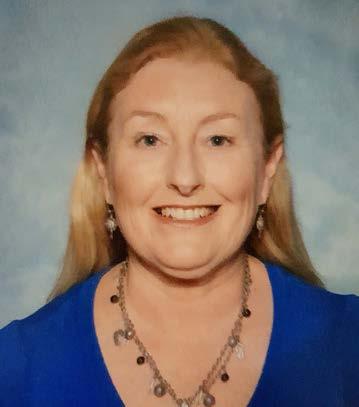
Speaking of the future, Future Science was be held on December 2nd at Edith Cowan University in Joondalup. This event proved to be a great opportunity for all science educators to participate in the many and varied workshops on offer, including those that will dealt with some of the more drastic changes to the curriculum, specifically General Human Biology and ATAR Psychology. Professor Steve Chapman, Vice Chancellor at ECU, opened the event and participants were treated to a keynote by Professor Michelle Colgrave. Michelle spoke about agriculture and the future of food, and invited us to consider alternative forms of protein such as crickets and meat and egg products created with biotechnology. As wars and natural disasters continue to cause havoc in the agricultural world with the potential for food shortages in our society, it was great to hear about possible solutions for the future. The atmosphere throughout the day was extremely positive, the exhibitors were varied, and the food was terrific. Thanks to John Clarke, Pamela Getalado and the team of volunteers who helped bring it all together.
The General Human Biology resources for Years 11 and 12 are now ready for publication and printing and will be available to assist teachers and students in this space, by providing guided text, activities and
PAGE 5 VOLUME 68 | DECEMBER 2022 JOURNAL OF THE SCIENCE TEACHERS’ ASSOCIATION OF WESTERN AUSTRALIA
questions for successful learning. STAWA will continue to update resources for senior subjects, especially as we navigate curriculum changes and the introduction of new subjects.
I would like to take this opportunity to sincerely thank Dr Siew Yap for her incredible work editing our Journal SCIOS. This task has been completed with professionalism and passion for imparting ideas for teaching and learning in science, reporting on events in the STAWA calendar, acknowledging award and prize winners throughout the year, and for sourcing advertisers. I always look forward to these publications that represent the work of Western Australian science professionals. Allan Knight, from SCSA and a long-time supporter of STAWA, has volunteered to take on this very important role.
STAWA
Year 11 and 12 ATAR Resources:
I hope that everyone enjoys the Christmas and New Year break. It has been a very challenging year with COVID continuing to disrupt peoples’ lives, teacher shortages and continual changes to expectations placed on teaching and support staff. At least we are now able to travel so I hope that you make the best of it, being able to visit family and friends, a privilege that has not been available for the last few Christmases!
The STAWA Exploring Chemistry, Physics and Human Biology series support the Western Australian Curriculum ATAR Courses.
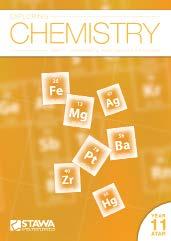
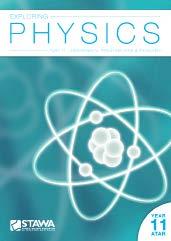
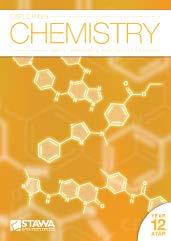
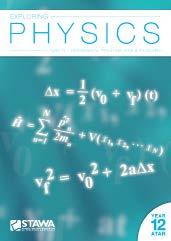
Human Biology General Course Resources: The STAWA Human Biology resources are available and together cover both the Year 11 and the Year 12 General Course.
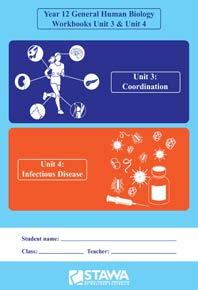
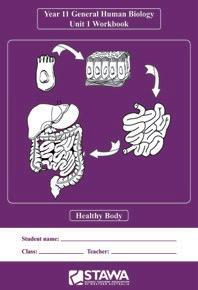
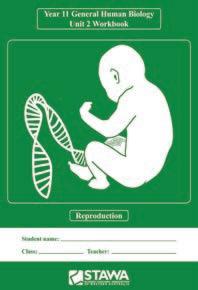
VOLUME 68 | DECEMBER 2022 JOURNAL OF THE SCIENCE TEACHERS’ ASSOCIATION OF WESTERN AUSTRALIA PAGE 6
Annabel Kanakis
Discount: Members receive a 10% discount on all purchases through
Member
STAWA.
PUBLICATIONS NEW EDITION COMING SOON! NEW EDITIONS COMING SOON!
CHIEF EXECUTIVE’S REPORT
John Clarke
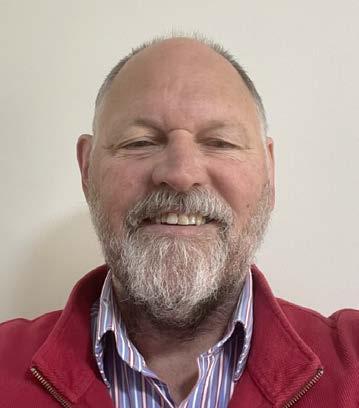
2022 is fast approaching its conclusion. Like me, I am sure that your pace has not waned as we approach the finish date at full pace.
STAWA properties and future home. Early in the year both the Cannington and Osborne Park properties were put on the market as discussed in the previous edition of SCIOS. Cannington sold very early and as expected, Osborne Park took a lot longer. The offer on Osborne Park has an expected settlement date on 20 Dec. The search is now on for a suitable home. In the interim, I have secured storage and office space at a considerably reduced rate through the generosity of Daniels Printing Craftsman who have been a great supporter of STAWA over many, many years.
Associate Membership - Psychology Teachers and Marine & Maritime Teachers. At the August AGM, an associate membership category was approved that would allow non-science teachers teaching Psychology and Marine and Maritime courses to join as associate members. We now have two types of associate membership categories: https://www. stawa.net/membership/join-now/. Take advantage of this reduced rate membership to access events and publications at member prices and member only opportunities such as the UWA Psychology online courses.
The November 2022 Marine and Maritime Teachers Forum, the second for 2022, took place on Friday 25 November at the Department of Primary Industries and Regional Development, 39 Northside Drive, Hillarys. The 25 teachers and numerous presenters enjoyed a great day of learning. To view the program visit the website https://www.stawa.net/conferences/marineand-maritime-teachers-forum/
The Synergy School Solar Challenge is back in play for 2023. Registrations are open and schools who have expressed an interest to participate have been sent invitations to register. Visit https://www.stawa. net/student-activities/synergy-schools-solar-challenge/ for dates, locations and the link to the registration site. Numbers will be restricted again in 2023 for metro events. So please register now to avoid disappointment.
CONSTAWA 41 Wednesday 18 April 2023 @ Willetton SHS: Planning for our Primary and Secondary Science Teachers Conference, has begun. The theme is Innovation – Powering our Future. We are calling for presenters. Both primary and secondary focussed sessions are needed. Whatever you have to offer, we would love you to share your expertise and experience. Register to present @ https://stawa.wufoo.com/ forms/2023-constawa-call-for-presenters/. Keep up to date with details via the STAWA web page https:// www.stawa.net/conferences/constawa/
PAGE 7 VOLUME 68 | DECEMBER 2022 JOURNAL OF THE SCIENCE TEACHERS’ ASSOCIATION OF WESTERN AUSTRALIA
Membership Renewals. STAWA has moved to an annual anniversary dated membership – January through to January. If you have or plan to renew November and December 2022 your membership will be carried through to the end of 2023. Angie will be following up with members in January and February to help with this our second year applying this model. Encourage your peers, particularly early career teachers to take up STAWA membership, to take advantage of the events and learning opportunities that STAWA provides and to actively seek to contribute to the goals of the association. Share your thoughts and ideas to help STAWA grow into the future. The strategic plan is under review but the current plan can be viewed at: https://www.stawa.net/about-us/constitution-andstrategic-plan/
HELD FROM 13 TO 21 AUGUST
2022 marked the 25 TH YEAR of the festival
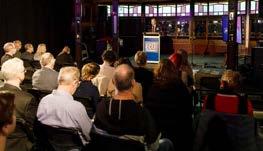
The Western Australia Coordinating Committee for National Science Week (WACC) and Inspiring WA supported the delivery of National Science Week to Western Australians through three grant programs, a state-wide marketing campaign and coordination of the WA launch event.
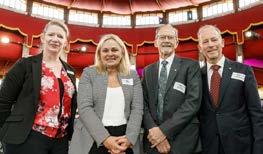
adopted the Australian Science Teachers Association theme – WA
GLASS: MORE THAN MEETS THE EYE.
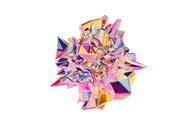
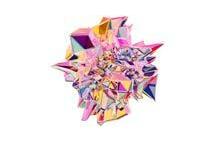
applied to marketing of National Science Week
In collaboration with Scitech’s Aboriginal Engagement Program (AEP), the WACC delivered a pilot Community Grant round with four remote
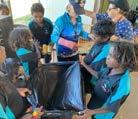
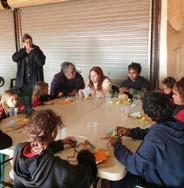
VOLUME 68 | DECEMBER 2022 JOURNAL OF THE SCIENCE TEACHERS’ ASSOCIATION OF WESTERN AUSTRALIA
IMPACT
Each received A successful networking launch was held
with addresses
WA –Professor
•
–Dr
Secretary
The
A total of provided by WACC to support grant initiativs. $71,984 $34,945 and a value of over The campaign had a reach of over 314,000 $154,000 $500 An estimated 4,776 individuals engaged through WACC supported activities 3,660 REGIONAL 1,096 METROPOLITAN events were registered across WA 214 $10,000 supported Mid-tier Grants of up 5WACC These events aligned with the 2022 theme and formed the flagship event in metropolitan Perth $2,500 supported Small Grants of up to 18WACC (Distribution of grant supported events marked on map) for regional events Government of Western Australia Department of Jobs, Tourism, Science and Innovation Enjoy a safe and enjoyable Christmas and new year holiday season. Your Chief Executive Officer, John Clarke
community schools.
at Edith Cowan University’s Edith Spiegeltent
by WA Chief Scientist and Patron of National Science Week
Peter Klinken
ChemCentre Forensic Scientist
Kari Pitts
for the Deputy Premier –Ms Sabine Winton MLA
Hon Roger Cook MLA provided a video address which was played for guests.
In our third instalment of from the archives, I look at the December editions of 1967, 1968, and 1969.
I don’t profess to be an historian. What I share is more of an observation that allows you the reader to draw comparisons with the past and present. Have fun.
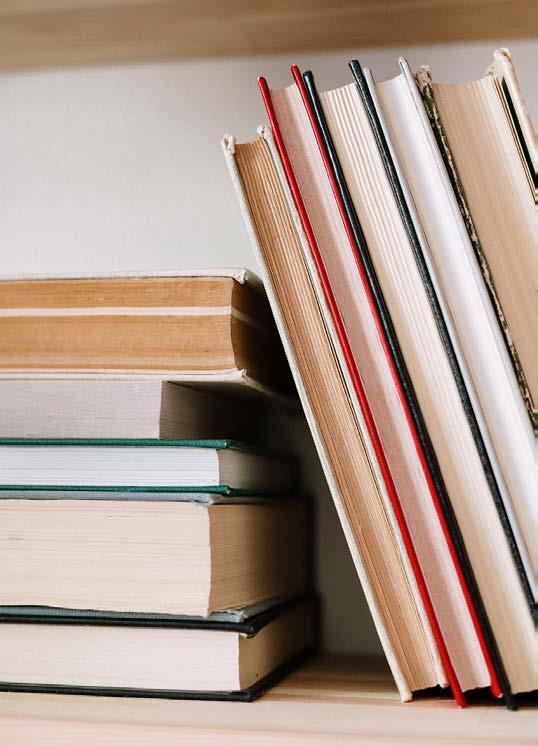
Why December issues? Term 3 is ATAR and exam time so I focused on December editions to see what I could find. I came upon a letter to the editor from David Hutchison December 1967 Vol. II No.4. He quoted from the H. G. Wells novel “The New Machiavelli” This makes for an interesting read. What were some changes from 1911 to 2022? Not much, I am afraid.
For the Biology teachers, did you grow up with the Web of Life textbook? In December 1968, I spotted an in-service course on the text. This is interesting, as is the language of the article.
FROM THE ARCHIVES
John Clarke
For the Physics teachers, let us look at December 1969. This is interesting particularly when considering the 54-year time difference between then and now, and the work done by the Einsteinian First program a partnership between STAWA and David Blair’s team at UWA. Has it been easy?
PAGE 9 VOLUME 68 | DECEMBER 2022 JOURNAL OF THE SCIENCE TEACHERS’ ASSOCIATION OF WESTERN AUSTRALIA
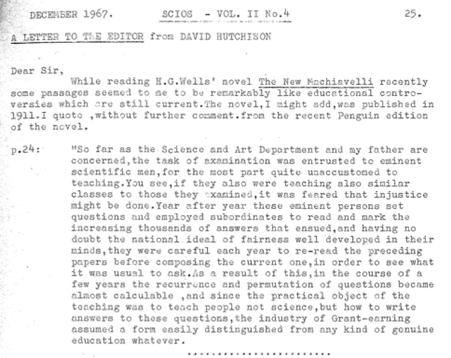
VOLUME 68 | DECEMBER 2022 JOURNAL OF THE SCIENCE TEACHERS’ ASSOCIATION OF WESTERN AUSTRALIA PAGE 10
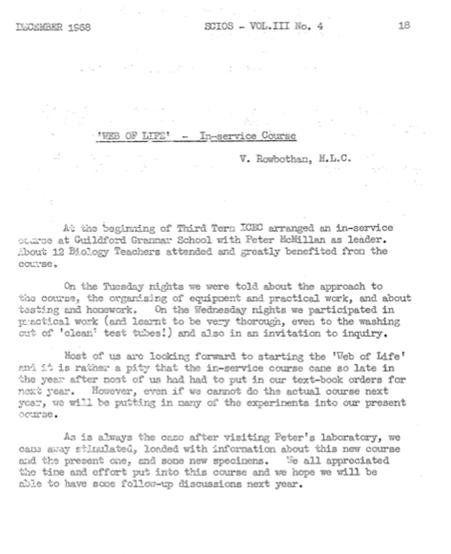
PAGE 11 VOLUME 68 | DECEMBER 2022 JOURNAL OF THE SCIENCE TEACHERS’ ASSOCIATION OF WESTERN AUSTRALIA
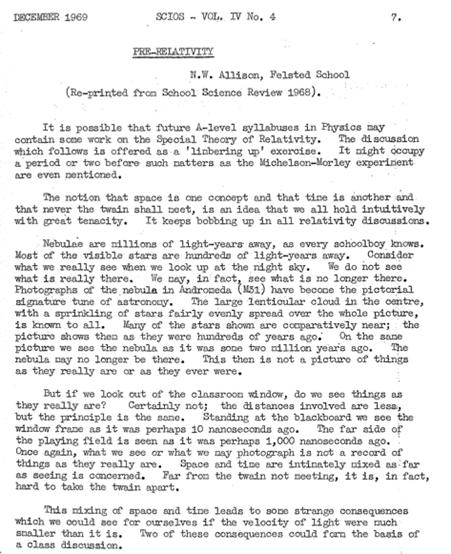
VOLUME 68 | DECEMBER 2022 JOURNAL OF THE SCIENCE TEACHERS’ ASSOCIATION OF WESTERN AUSTRALIA PAGE 12
YOUR CHANCE TO SHINE!
Now calling for presenters for CONSTAWA 41 (April 18th 2023)
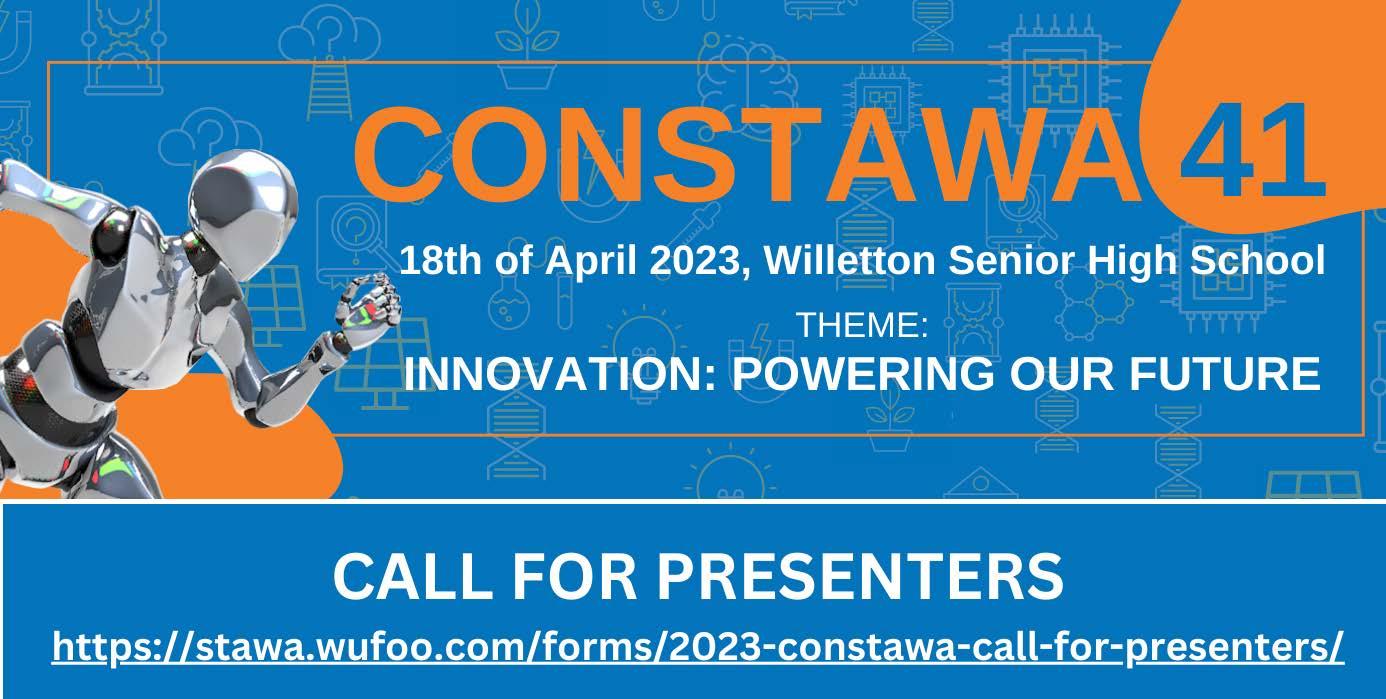
Do you have a great science activity, idea, lesson, technique, program or any other science resource which you would love to share with other passionate Science teachers?
Then we are keen to have you share this at CONSTAWA on Tuesday, 18th April 2023
Both primary and secondary focussed sessions are needed – in fact we often have presentations that cover a wide range of the school years as well as sessions that may be of general interest to all teachers.
Whatever you have to offer – we would love you to share your expertise and experience.
The application process is easy, just follow the link here to register your interest. You have until Tuesday, 18th April to prepare your session BUT you must register to present by close of business on Tuesday, 31st January 2023
This sounds a long way away but life gets busy… so why not register today or ASAP so you don’t miss out on sharing your ideas.
Not feeling confident to present on your own? Then why not buddy up with someone and do a joint presentation?
Teachers attend CONSTAWA to find inspiration from other teachers – perhaps you are THAT inspirational teacher!
(Of course - you can use presenting at CONSTAWA as an opportunity to support your teacher development - that is just a bonus!)
Register here: https://stawa.wufoo.com/forms/2023-constawa-call-for-presenters/
PAGE 13 VOLUME 68 | DECEMBER 2022 JOURNAL OF THE SCIENCE TEACHERS’ ASSOCIATION OF WESTERN AUSTRALIA
WA ROBOTICS PLAYOFFS SHOWCASES YOUNG TECHNICAL SKILLS
Suzanne Hawkes
High schoolers from across WA were thrilled to pit their homemade robots against each other in the ultimate tests of technical skills and strategy at the recent WA Robotics Playoffs and Agricultural Games (WARP). The event at Curtin University Stadium on 27 and 28 August was the result of a collaboration between the Department of Primary Industries and Regional Development (DPIRD), Curtin University and Murdoch University.
While not competing, the students were able to explore a technology and careers expo and speak to industry professionals about the diverse range of exciting careers on offer in primary industries. Highlights included sheep shearing demonstrations by Australian Wool Innovation, a VR fishing vessel experience hosted by Austral Fisheries and the chance to drive robots simulating the loading of hay bales.
Within the Murdoch University marquee at the expo, eight industry professionals shared their own career stories and the joy of working in primary industries. Among the speakers were DPIRD research scientist Richard Fennessy who described how a love of science and a summer job picking grapes led to a career in Viticulture which has seen him work in some of the best vineyards in California, France and Australia. Meanwhile Mary Karborani explained how her passion for science led to an engineering degree and then on to her current role as head of business services for CBH Group.
The winning team from Peter Carnley Anglican Community College pose with their trophy.
Left to right: Byron Silchinger, Hon. Alannah MacTiernan MLC, Caleb Whyte, Harlene Hayne (VC Curtin University), Felix Abbott, Stephanie Beaumont Cabrera and Kim Flintoff
Meanwhile, inside the stadium student teams from Peter Carnley Anglican Community School, Willetton SHS and the Australian Islamic College competed in the Innovation Challenge. These teams chose from four potential challenges – real life problems faced by primary industries– presented their research and
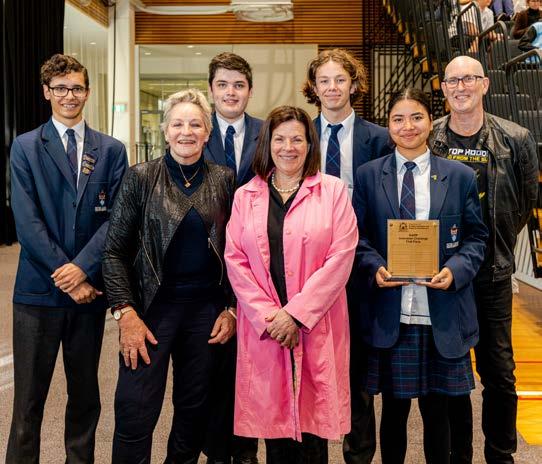
VOLUME 68 | DECEMBER 2022 JOURNAL OF THE SCIENCE TEACHERS’ ASSOCIATION OF WESTERN AUSTRALIA PAGE 14
suggested solutions to a team of judges comprised of farmers, ex-teachers and PHD students.
The Year 11 team from Peter Carnley Anglican Community School took out top spot, bagging themselves a trophy to add to their cabinet and $750 to spend on STEM equipment for the school. They chose the climate change challenge and presented a very well-thought-out solution comprising of a hydroponic farming system to address the issue of growing crops in an environment with decreasing rainfall. Two teams from the Australian Islamic College claimed second
and third place, winning $500 and $250 respectively to purchase STEM equipment.
In the arena, robots representing 20 teams, including six new schools sponsored by DPIRD, battled it out. to reign supreme in this year’s competition. DPIRD sponsored Wanneroo SHS to enter the competition
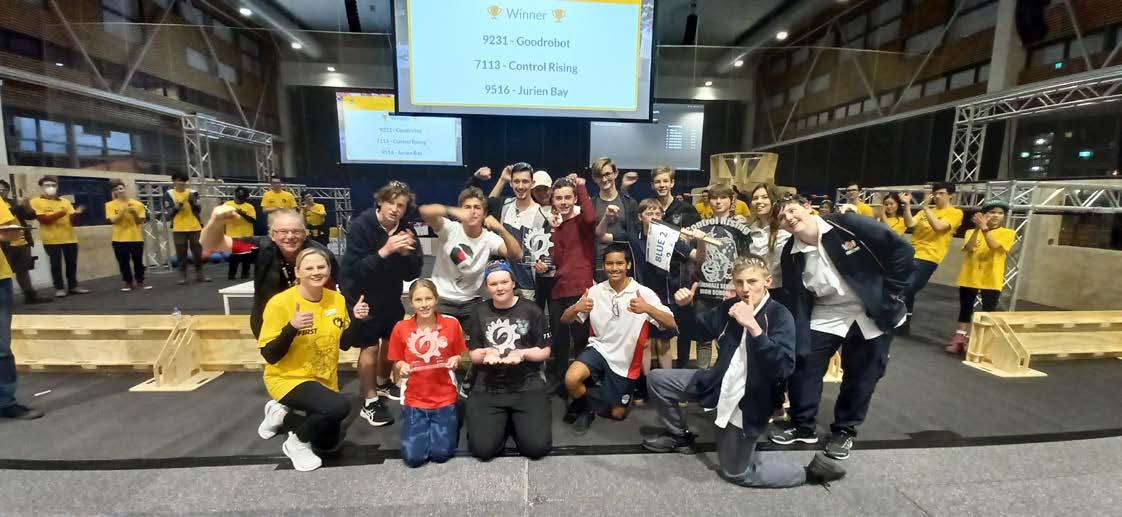
The robots were designed to play basketball, with the robots capable of collecting balls straight off the arena floor or these could be manually loaded from the boundary line. The teams then directed their robots to launch the balls into a target basket. For extra points, teams could choose to include a climbing arm which was used to lift their robot off the arena floor to hang from a scaffold at the end of the match. Teams competed in three-on-three qualification matches, with the top six-ranked teams winning the right to select from the other teams to form super team alliances for the finals. Jurien Bay SHS, Armadale SHS and an independent team from Bunbury formed an alliance combining a strong defensive robot, an impressive launch robot and an outstanding climbing robot to take out the title.
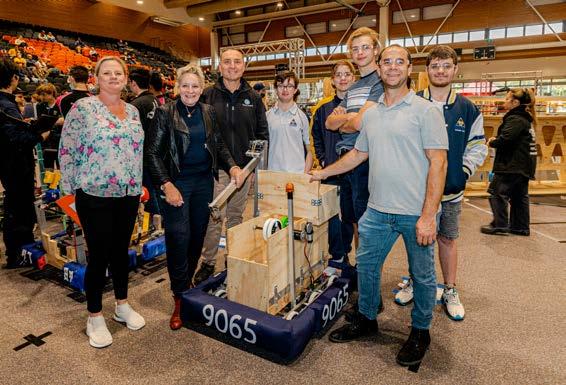
PAGE 15 VOLUME 68 | DECEMBER 2022 JOURNAL OF THE SCIENCE TEACHERS’ ASSOCIATION OF WESTERN AUSTRALIA
WARP will return August 2023 so watch this space!
DPIRD sponsored Wanneroo SHS to enter the competition.
Left to right: Suzanne Hawkes- DPIRD, Hon. Alannah MacTiernan MLC, Paul Moro, Ryan Glaus-Johnson, Owen Maunder, Arlin Rumens-Climo, Gavin Noack, Juan-Roux Weiderman
WARP 2022 winners. Left to right: Dave Berryman- Murdoch University, Suzanne Hawkes- DPIRD, Ethan Powell, Porscha Deane, Loki Kelly, Christopher Wilson, Scott Mader, Willem Botha, Cooper Cohen, Joeross Lendio, Connor Goodlad, Caden Jones, Luke Fullwood, Tyler Sheahan, James Bone, Taylor Begley, Lachlan Marriot
BUILDING BARCODING TO SAVE BIODIVERSITY
Pauline Charman
The new era of EnviroSTEM for Schools– Harry Butler Institute Education Program invites schools to be a part of the solution in West Australia. Look out as Big Data, Genomics, AI, Waste Management and more are coming in 2024.
“Keep Caring. This is our only world.” Harry Butler
Since 2020, Australian schools have been challenged with some of the most significant disruptions ever faced. A pandemic and extreme weather events (fires/floods) have thrown school communities into chaos. The world as we knew it, changed forever. A new West Australian partnership of social enterprise, BioBarcode Australia and the Harry Butler Institute at Murdoch University will be providing new educational experiences and resources that prioritise students as ‘active contributors’ to problem solving. The programs in development currently involve data collection and immersive research contributions while learning how West Australian environmental sustainability research is world class and technology driven; all proudly embracing two-way science exchange with Indigenous knowledge to solve our biggest problems.
The Harry Butler Institute, Murdoch University’s worldleading environmental research institute, comprised of four research centres, including the Centre for
Biosecurity and One Health, the Centre for Sustainable Aquatic Ecosystems, the Centre for Terrestrial Ecosystem Science and Sustainability, and the Centre for Water, Energy and Waste
The Institute impressively leads in this research field via collaborative work with industry, government and community to develop innovative solutions to complex environmental problems. Research topics including renewable energy developments, novel geopolymer concrete development, waste management solutions, algal research and biotechnology, oceanography and marine ecology, fire ecology, island biosecurity, dolphin and sawfish research, extractive metallurgy and tailings waste treatment, unique conservation initiatives, freshwater ecology and conservation, preventing species extinction, biosecurity and pest management, environmental restoration, ticks and tick diseases, the use of AI and robotics, and many more.
WA science educator and ‘biotech ed guru’ leader Pauline Charman founded BioBarcode Australia in 2020 with the vision to provide opportunities for Australian schools to identify, map, and monitor species in their school grounds using DNA barcoding. The data generated is then contributed to authentic genomic reference libraries of species which contributes to building our knowledge of biodiversity.
VOLUME 68 | DECEMBER 2022 JOURNAL OF THE SCIENCE TEACHERS’ ASSOCIATION OF WESTERN AUSTRALIA PAGE 16
Using portable research grade equipment and safe, user-friendly protocols, the first trial was successfully run at Willetton Senior High School in 2022. New loan kits of equipment available through the Education Dept Regional Laboratory Technician Pool as of 2023 and BioBarcode, schools can begin to participate in these exciting hands on and relevant STEM opportunities that offers it all – field collection, lab work and computer data analysis.
Now, Pauline and BioBarcode is partnering with the Harry Butler Institute to begin the process of developing education programs that will be introduced from 2023 and 2024 when the Harry Butler Science Centre opens on the edge of the Beeliar National Park at Murdoch University. Experiences and resources featuring current WA based research, data collection opportunities via citizen science projects, wetland field visits (The Wetlands Centre Cockburn and Herdsman Lake Discovery Centre) and environmental engineering aimed at solving our biggest challenges including reduction in waste, renewable energy options and sustainable water resource management would all be on offer.
You may check out the new Harry Butler Science Centre on https://youtu.be/OGmrrldrw6E
About the Author
Pauline Charman is the Education Officer at the Harry Butler Institute at Murdoch University. She is working in partnership with the Wetlands Centre Cockburn to build innovative, collaborative educational programs with an emphasis on two-way science exchange underpinned by local Indigenous knowledge and the Institute’s research projects.
Pauline is a highly experienced science educator, having held a variety of roles in WA secondary education and established WA’s first immersive biotechnology education centre for schools at the Harry Perkins Institute of Medical Research in 2013. She founded BioBarcode Australia in 2020 with the vision to demystify DNA for the community.
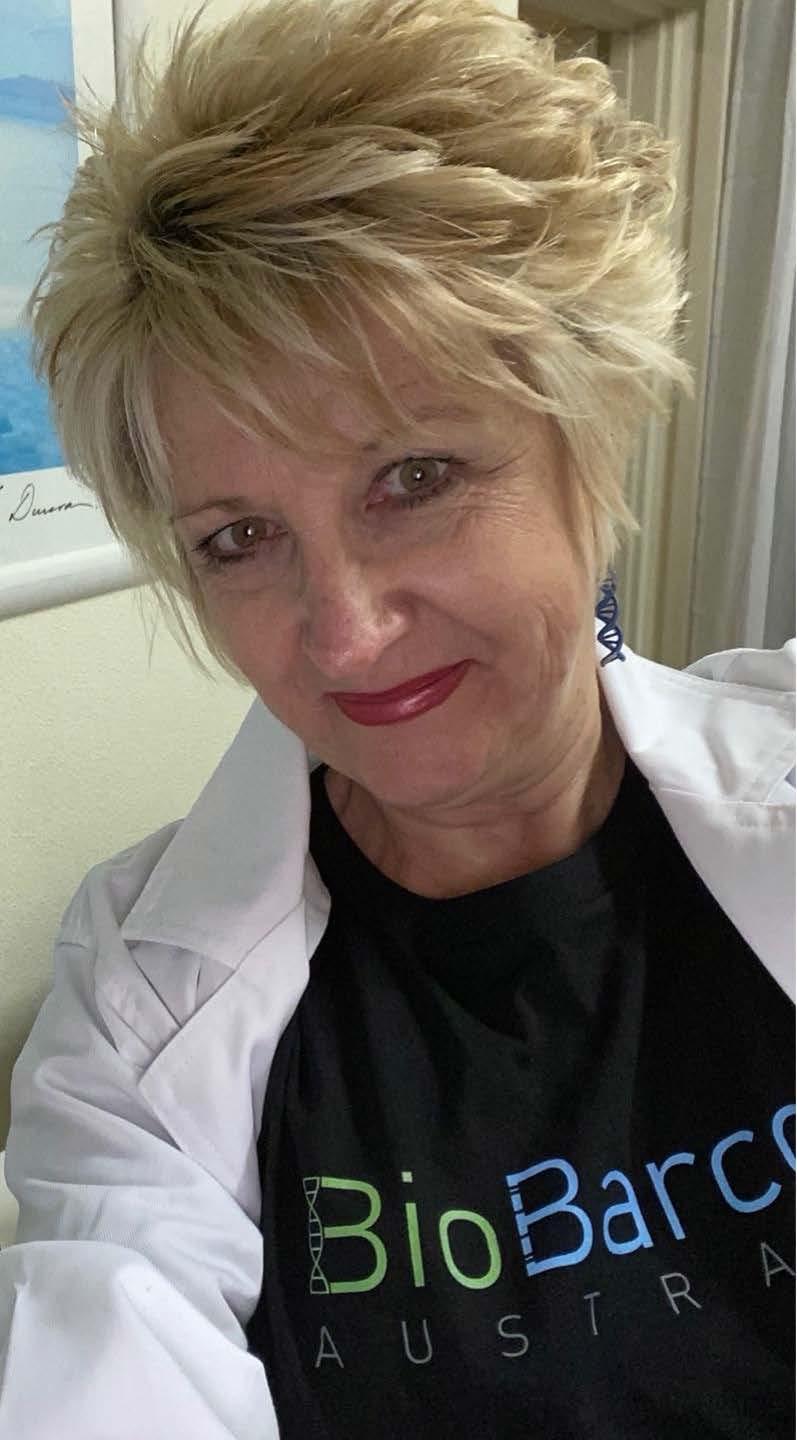
PAGE 17 VOLUME 68 | DECEMBER 2022 JOURNAL OF THE SCIENCE TEACHERS’ ASSOCIATION OF WESTERN AUSTRALIA
BUSH BLITZ
Sarah Lacey & Kerry Mazzotti
Article by Sarah Lacey
Bush Blitz TeachLive is a professional development program like no other. It was fascinating, exciting but grueling all at the same time. Bush Blitz is a program dedicated to discovering undescribed species in remote Australian locations. Bush Blitz TeachLive is a program which invites teachers to attend the Bush Blitz expeditions to learn how scientists conduct their work and deliver this to students.
The July 2022 Bush Blitz TeachLive location was on Wilinggin Country, in the remote West Kimberley, based at the Charnley River Station just off the Gibb River Road. The Bush Blitz team consisted of scientists from the WA Museum, WA Herbarium, Museum & Art Gallery NT, Queensland Museum, University of NSW, South Australian Museum, Adelaide University as well as people from the Australian Wildlife Conservancy, WA Department of Biodiversity, Conservation and Attractions, and Earthwatch. We were also assisted by the Wunggurr Rangers and the Traditional Custodians of Wilinggin Country, the Ngarinyin People. The scientists were varied in their fields, including experts in botany, molluscs, fish, reptiles, arachnids, parasitic wasps, butterflies, and true bugs, and each had different collection techniques and skills to learn. I was consistently in shock, wondering how I found myself in the most beautiful wild locations looking for new species with those that were experts in their field.
So, what did I do? – So much!
Bush Blitz TeachLive provides hands-on learning in a way that no other PD can. I have been asked by colleagues on my return to tell them the “best bit” and I have tried and failed so many times to come up with just one. In truth, the highlight was being there and getting to see how the science works in the field. It didn’t matter which team I went out with. There was always some new highlight just as good as one from the previous day. Was it the hike to a top of a hill to catch butterflies for hours? Or was it swimming in a gorge to find molluscs? Or the rock climbing to get the very particular new plant? Or the looking in crevasses for spiders? I can’t narrow down to just one highlight. Nor can I put into words the pure joy I felt from these activities.
Following are highlights from each day. For more detail look at Blog | Earthwatch Institute
VOLUME 68 | DECEMBER 2022 JOURNAL OF THE SCIENCE TEACHERS’ ASSOCIATION OF WESTERN AUSTRALIA PAGE 18
Day 1
Watching arachnid experts Mark Harvey and Jeremy Wilson dig a tarantula from her burrow.
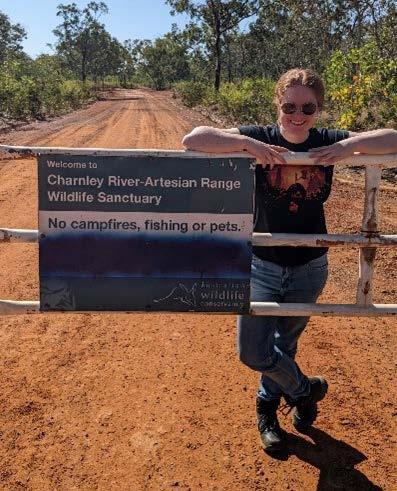
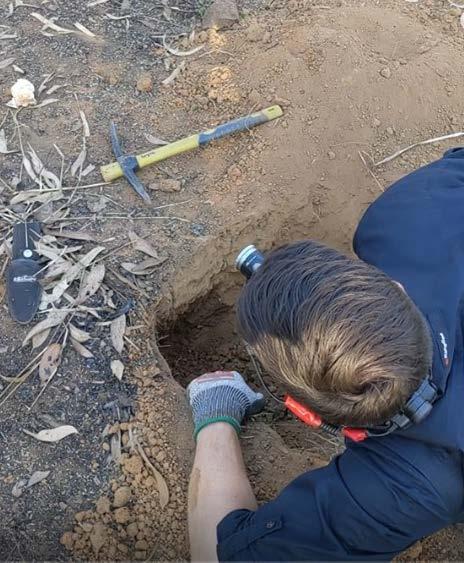
Day 2
Finding just how hard it is to catch a flying invertebrate in a picturesque gorge.
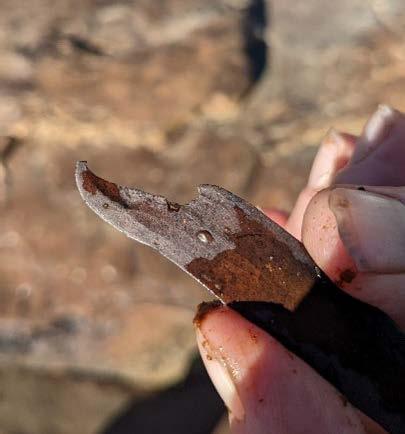
Day 3
Accidentally finding a new population of limpets (Stimulator consetti) in an unexpected habitat with mollusc expert Lisa Kirkendale.
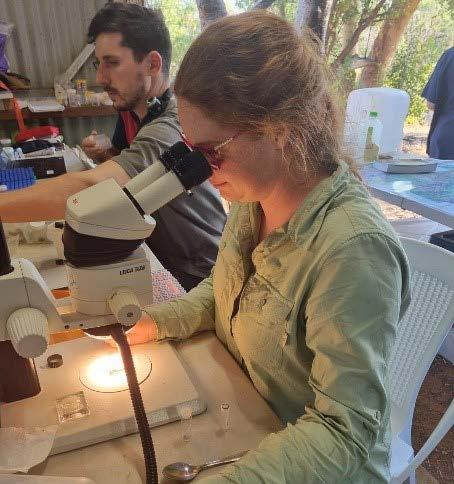
Day 4
Chasing butterflies on a hilltop with Rod Eastwood (after connecting with my Year 11 Biology class from the field).
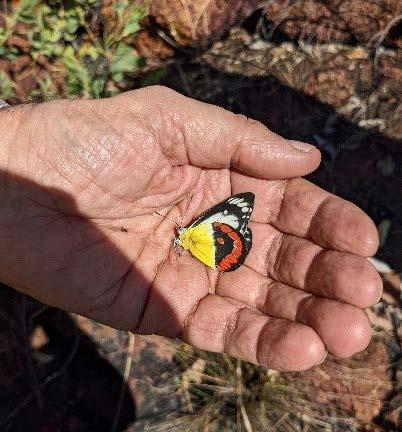
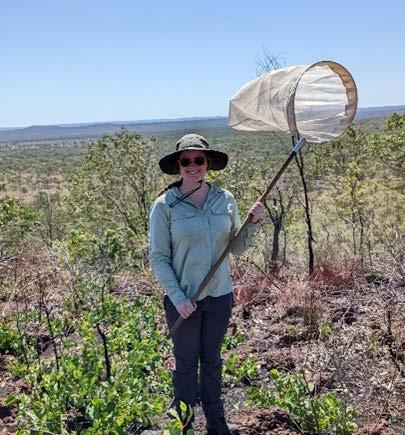
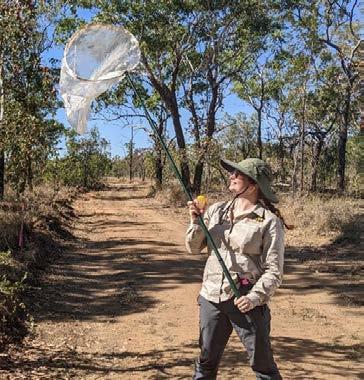
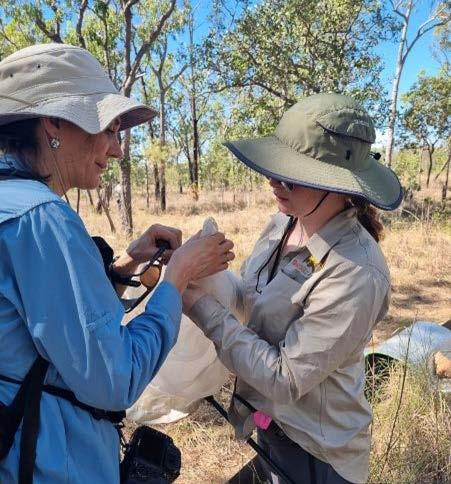
PAGE 19 VOLUME 68 | DECEMBER 2022 JOURNAL OF THE SCIENCE TEACHERS’ ASSOCIATION OF WESTERN AUSTRALIA
Day 5
Hunting spiders (after connecting with my Year 8 class from the field).
Day 6
Pressing plants under a waterfall with a team of excited botanists.
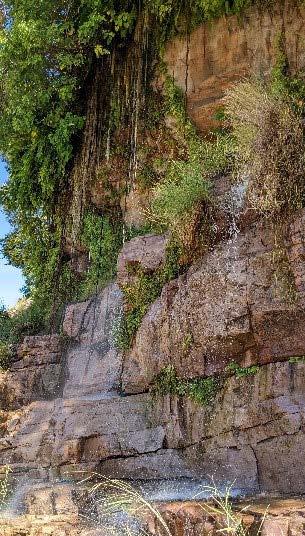
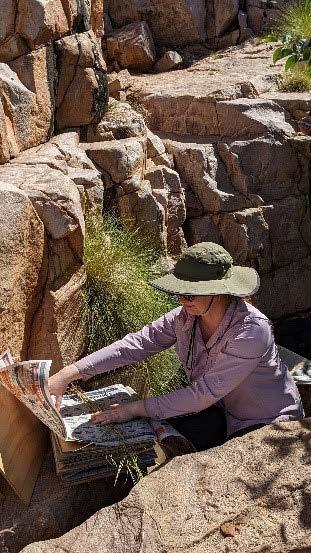
What’s next?
I am now in the process of writing a mini BushBlitz program for my Year 9’s, with so many ideas and a much better understanding of what a field biologist does. There is so much to explore and find even in the garden at school and I aim to encourage students to look for these examples of biodiversity to inspire them into a biology-based career.
If you are interested in an expedition, look out for the opening of applications for the next Bush Blitz TeachLive expeditions at Bush Blitz TeachLive - ASTA
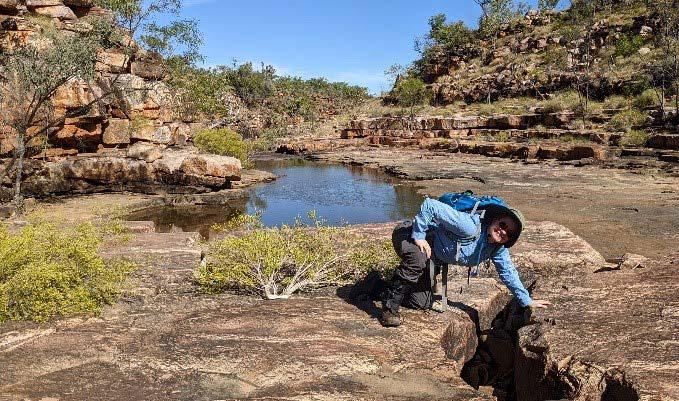
About the Author
Sarah Lacey is a Biology teacher at Swan Valley Anglican Community School. She has a love for her gardens, Pomeranians, and fantasy books. In Sarah’s spare time, you will either find her in a pool or on her aerial silk.
VOLUME 68 | DECEMBER 2022 JOURNAL OF THE SCIENCE TEACHERS’ ASSOCIATION OF WESTERN AUSTRALIA PAGE 20
Science in the Wild Article
by Kerry Mazzotti
Where is the wildest place you have ever been?
This is the question I asked my students when introducing Bush Blitz – the species discovery expedition I embarked on in Term 3 this year.
I teach science from Pre-Primary to Year 6 and the responses were as diverse as the students that walk into my room. Camping in the Pilbara, on the ocean in a boat, Kings Park, the Zoo, the local park (because there’s bugs there) right through to military conflicts in Pakistan - these were the experiences of wild places for my students. This was the start of a biodiversity theme that has made an indelible imprint on my teaching.
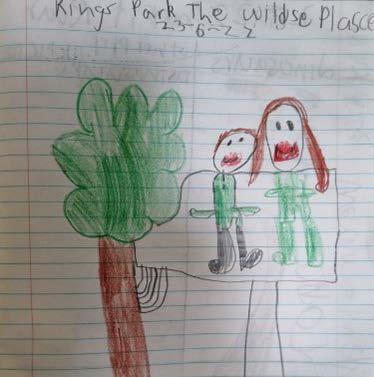
Bush Blitz is a fully funded week-long professional learning experience for primary or high school teachers of science. Teachers work along-side top research scientists on a biodiversity survey in some of Australia’s wildest places. Teachers share the experience with their students through daily blog posts and a live-cross back to the school.
A couple of passionate arachnologists and a reclusive tarantula greeted us when we arrived at base camp at Charnley River Station, a remote wilderness sanctuary on Wilinggin Country in the West Kimberley.
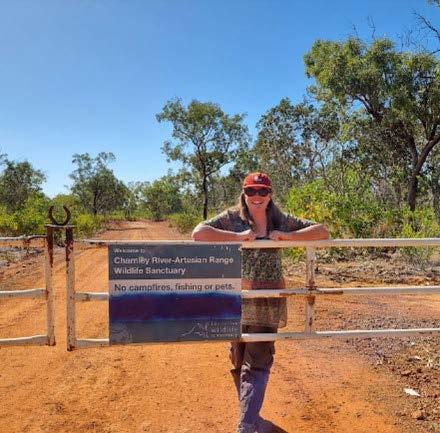
It had already been a big day. We had met up with the other four teachers the day before in Broome and our day had been spent bumping along the Gibb River Road between Derby and Charnley River Station. The scenery was spectacular, and we were a bundle of energy waiting for our adventure to begin.
It was fitting then, that upon arriving, Dr Mark Harvey from the WA Museum and Dr Jeremy Wilson from Queensland Museum beckoned us to watch them dig out a tarantula from her burrow, just across the creek from base camp. Our species discovery adventure had begun!
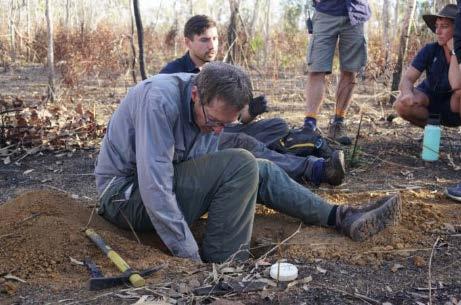
PAGE 21 VOLUME 68 | DECEMBER 2022 JOURNAL OF THE SCIENCE TEACHERS’ ASSOCIATION OF WESTERN AUSTRALIA
Me standing at the gate to Charnley River Station.
Dr Mark Harvey and Dr Jeremy Wilson digging out a Tarantula.
Kings Park was the wildest place one of my students had ever been.
The days were long. After the full day of travelling and the tarantula excitement, I was ready to crash in my tent. The scientists, however, were still busy in the makeshift ‘lab’ (the only place at camp with Wi-Fi). They sorted samples, wrote field notes, and photographed specimens. The passion, adrenaline and dedication were palpable – even though the scientists had already been in the field for a week by the time we arrived.
Before we went to bed, we checked the chopper schedule – a whiteboard with photos and notes scrawled across it denoting who would be going where on the following day.
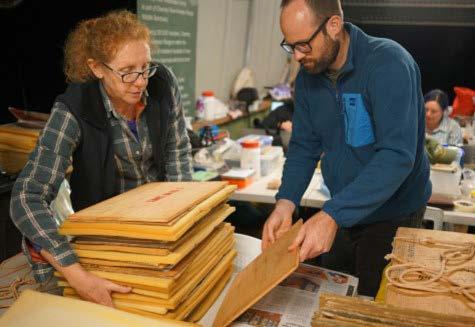
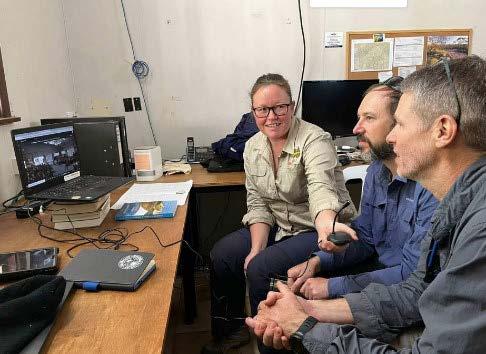
Breakfast was at 6:30 am. Our camp cooks were some of the most valuable members of the team and provided bread, wraps, sandwich fillings, fruit, and snacks so we could pack a lunch to take into the field. Everyone would meet back for dinner at 6:30 pm.
After breakfast we headed to the lab with our daypacks. We would meet up with our team of scientists for a day in the field. Teachers assisted different teams each day. Sometimes we took out a 4WD; sometimes we flew by chopper to more remote sites.
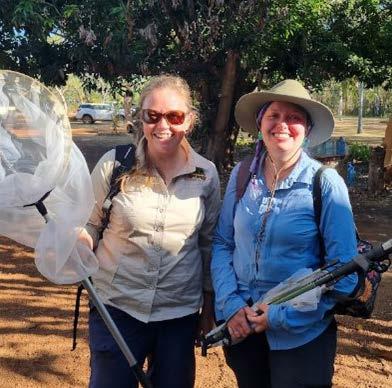
Collaboration with the Traditional Owners and Wunggurr Rangers was crucial to the expedition. We were visiting sites brand new to science but etched in the cultural history of the region’s First Peoples. Traditional Owners provided ecological knowledge as well as guidance on areas that could be surveyed and others that were important cultural sites.
Over the following week, I found a tiny Dodder flower with the botany team, a parasitic wasp and Assassin Bug with the entomologists and a poisonous butterfly with the sole lepidopterist on the expedition. I ate green ants because the Parks and Wildlife rep said it was a good idea (it was, so tangy!). I kissed a Cherebin (a giant freshwater prawn) and saw wild Cockatiels. I clambered through gorges, travelled by helicopter, and swam in deep waterholes. You can read all about these adventures on my daily blog from the expedition at https://www.earthwatch.org.au/Blogs/teacher-blog
VOLUME 68 | DECEMBER 2022 JOURNAL OF THE SCIENCE TEACHERS’ ASSOCIATION OF WESTERN AUSTRALIA PAGE 22
Dr Ben Anderson and Dr Shelley James from the WA Herbarium press samples in the ‘lab’ at base camp.
Me standing with Dr Erinn Fagan-Jeffries preparing for a day in the field with the entomologists.
Crossing live to my school with Dr Michael Hammer from NT Museum and Dr Glenn Moore from WA Museum.
Photo: Lynette Hillier
On Day 5 I crossed live back to my school. Hundreds of eager faces peered back at me from the laptop screen. My whole school had gathered in the undercover area to watch me interview a few of the research scientists on the expedition: Dr Erinn Fagan-Jeffries from The University of Adelaide, Dr Michael Hammer from NT Museum and Dr Glenn Moore from WA Museum. This experience made science real for the students. Scientists were no longer animated older men with frizzy grey hair in lab coats, they were young women with purple hair, wearing gators and wielding a butterfly net, or a couple of friends talking about the fishing they had done across the country and the world.
I was thrilled to hear about the students following my journey while I was away. Classroom teachers read daily blogs and the school posted my photos on their Facebook page. Although my adventure was taking place 2500 kilometres away, the students were shadowing me, sharing in the excitement, walking sideby-side with the scientists just like I was.
I developed a series of lesson plans for Bush Blitz titled ‘Science in the wild.’ I was piloting the lessons with a group of self-proclaimed ‘Eco-Warriors’ that I met with before school on a Monday. Dr Erinn FaganJeffries was a crucial part of the program, zooming in to our meetings from Adelaide University. The students were thrilled to be doing ‘real science’ guided by ‘real scientists’.
In 2023, our school will continue its focus on biodiversity thanks to funding provided by Bush Blitz to implement post-Bush Blitz programs. We will be connecting with the research scientists on an excursion to Boola-Bardip (the Western Australian Museum, Perth). We will be restoring local areas by participating in planting days with the local Landcare group and we will be improving the biodiversity of our own school by planting a native habitat garden.
Like many aspects of teaching, it is challenging to measure the impact of Bush Blitz. Wilinggin Country (West Kimberley) is the wildest place I have ever been, and Bush Blitz connected my students to the experience
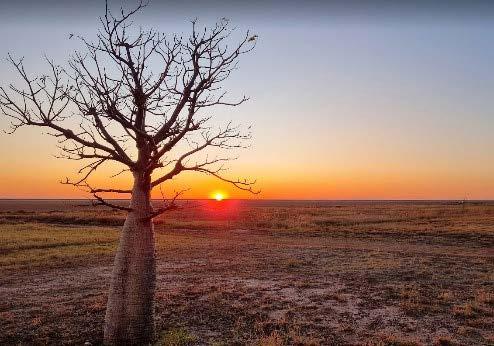
and to the scientists, in a way that will impact teaching and learning in my classroom for years to come.
If you would like to share the wild side of science with your students, you can find out more about Bush Blitz including the 2023 expedition to the Esperance region by visiting: https://asta.edu.au/programs/nationalprograms/bush-blitz-teachlive/
Why not apply and experience science in the wild?
About the Author
Kerry Mazzotti is a primary science teacher at Southern Grove Primary School in Perth’s south-east. Before landing in the classroom, Kerry worked in the field of sustainability and science communication across the government and non-government sectors. Her interests include bike riding, photography and helping little people find answers to big questions, mostly about slaters.
PAGE 23 VOLUME 68 | DECEMBER 2022 JOURNAL OF THE SCIENCE TEACHERS’ ASSOCIATION OF WESTERN AUSTRALIA
Science in the wild - boab at sunrise.
DIGGING FOR DINOSAURS
Emily Taylor
Introduction
After seeing some of the newer Primary Connections titles (Dinosaurs and More), I decided to swap minibeasts for dinosaurs in Year 1 Biological Science. Without a doubt, digging for dinosaurs was the highlight of the term. When they step into the shoes of a palaeontologist and begin uncovering fossils, hums of excitement, curiosity, and discovery fill the room. After learning about dinosaurs all term, I used this lesson to conclude my unit. I set the scene for this activity by reading the book ‘When Sue Found Sue: Sue Hendrickson Discovers Her T-Rex’ by Toni Buzzeo and Diana Sudyka. Alternatively, you could read an information text about palaeontologists or dinosaur fossils. You could also use this lesson idea to introduce the topic and guide an inquiry process to learn about the dinosaurs they find.
Logistics to Consider
• I highly recommend purchasing multiple sets of dinosaur skeletons so you can make all the digs in one afternoon. I needed six skeletons/ digs for each of my classes. I made 24 in total.
• The quantity of sand/ plaster mix needed will depend on the volume of your foil trays. For example, my trays were 21x15x4cm (1.3L). I purchased a 6kg bag of Plaster of Paris and two 20kg bags of sand for 24 dinosaur digs.
• Plaster of Paris stiffens quite quickly; smaller batches are easier to manage than large batches.
• Digging for dinosaurs is a dusty task, best completed outdoors if possible.
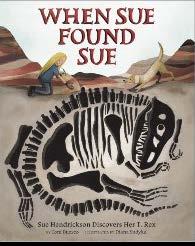
• You can adjust the difficulty of the dig by increasing or decreasing the amount (volume) of plaster. However, be mindful that the longer you leave the plaster to set, the more it hardens.
1 plaster: 2 sand: 1 water 1 plaster: 3 sand: 1.25 water 1 plaster: 4 sand: 1.5 water
Firm mix Dig time >20 minutes *May require metal utensils. Students should wear safety glasses
Equipment
Medium mix Dig time ≈ 15minutes Soft mix Dig time <10 minutes
Dinosaur skeletons
Rubber gloves
Plaster of Paris
Dust mask
Washed soft play sand
Safety glasses
Small Foil trays
Selection of excavation tools: Wooden chopsticks/ spoons/ knives & paint brushes
Brown edicol dye
Bucket
Strong stirring spoon • Measuring cup/jug • (Optional) Additional small items such as rocks, minerals, or plant matter for students to find
VOLUME 68 | DECEMBER 2022 JOURNAL OF THE SCIENCE TEACHERS’ ASSOCIATION OF WESTERN AUSTRALIA PAGE 24
•
•
•
•
•
•
•
•
•
•
•
Making the Dinosaur Digs
1. Find a well-ventilated outdoor area to set out your trays and organise dig items. I included a skeleton, fool’s gold, stones, and woodchips.
2. Safety first! Before using the plaster, carefully read the product label and the Material Safety Data Sheet (often available online). Wear safety glasses, gloves and a dust mask to avoid eye or skin contact and inhalation.
3. Measure dry ingredients by volume into a bucket. Ensure it is well combined before adding half of the water. Stir and then continue adding water until the mixture resembles a toothpaste consistency.
4. Spread a thin layer of the dig-mix in each tray. Then, add the skeleton (along with other items) and cover it with the remaining mixture (leaving space for a coloured top layer).
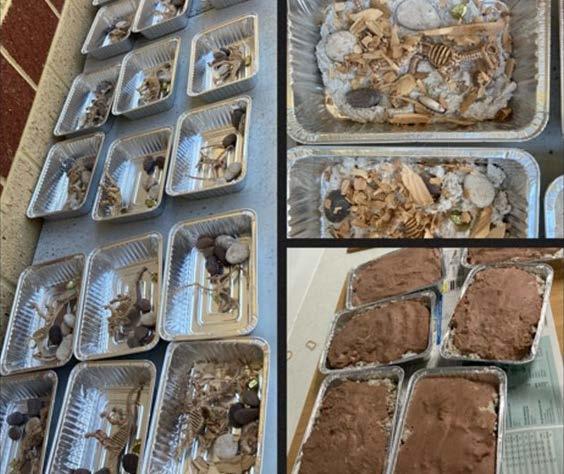
5. Continue making batches until all trays are filled.
6. Make 1-2 final batches, including a few shakes of brown edicol dye. Add a layer of brown mix to each tray.
7. Leave to harden in a warm, sunny spot for at least 24 hours.
Teaching Tips When Digging for Dinosaurs
• Student safety: When digging, students can accidentally flick sand. Students should wear safety glasses to prevent injuries, especially when using firmer mixes.
• Before the students start, discuss how they think a palaeontologist would use their tools. They must carefully dig and search for fossils ensuring that nothing gets broken. It is important to reinforce how to use their tools safely.
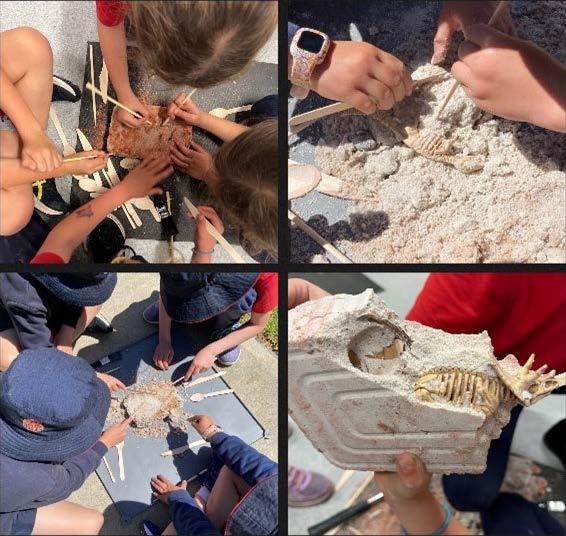
• Once the dig is underway and fossils begin to be uncovered, guide discussion by asking questions. For example, “What feature can you see on this fossil? I wonder what it might eat with those sharp teeth?”
• Create a word wall for students to refer to while they annotate a picture of their dinosaur discovery.
Curriculum Alignment
Year 1/ Science Understanding/ Biological Sciences:
•
Living things have a variety of external features (ACSSU017)
• Students will identify common external features as the fossil is released from the dig. These may include legs, wings, plates, spikes, crests, beaks, teeth, and claws.
• Students will make simple links between types of external features and how a dinosaur moves, where it lives and what it eats. For example, a dinosaur with short legs and flat feet moves slowly on land, and a dinosaur with sharp teeth is probably a carnivore.
PAGE 25 VOLUME 68 | DECEMBER 2022 JOURNAL OF THE SCIENCE TEACHERS’ ASSOCIATION OF WESTERN AUSTRALIA
Making Dinosaur Digs.
Students digging for dinosaur fossils.
Student work examples.
Year 1/ Science as a Human Endeavor/ Nature and Development of Science:
• Science involves observing, asking questions about and describing changes in objects and events (ACSHE021)
• Topics to discuss and explore: What does a palaeontologist do? Why are scientists interested in learning about the past? You can make connections between the extinction of dinosaurs (an uninhabitable environment with no food) and sustainability.
Year 1/ Science Inquiry Skills:
Use a range of methods to sort information, including drawings and provided tables. Through discussion, compare observations with predictions (ACSIS027) Represent and communicate observations and ideas in a variety of ways (ACSIS029).
• Using a photo or drawing, students will annotate the external features of their dinosaurs.
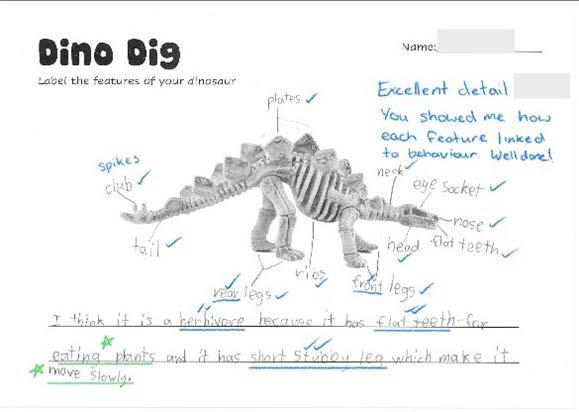
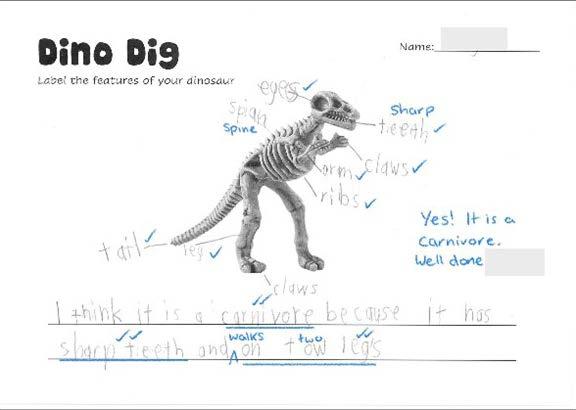
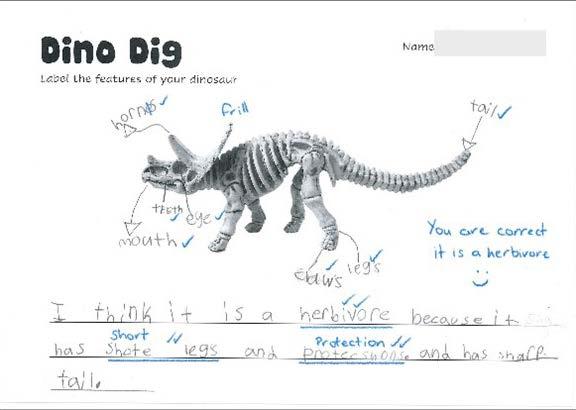
• Based on the features of their fossil, students will draw conclusions about their dinosaur’s habitat, behaviour, and diet.
• Students will share their findings in guided small groups or whole class discussions.
Other Useful Resources
• I used “Primary Connections: Dinosaurs and More” to plan the unit of work leading up to this activity.
• For simple diagrams of dinosaur body parts, I sourced posters from Twinkl Australia.
• For dinosaur research, My Encyclopaedia of Very Important Dinosaurs by DK is easily accessible to young readers.
About the Author
Emily Taylor is a primary science teacher at Glengarry Primary School in Perth, Western Australia. She teaches Year 1 – 6 students in a purpose-built lab. She has a passion for teaching science as she believes science lends itself to many hands-on learning opportunities and there are countless topics to engage every student.
VOLUME 68 | DECEMBER 2022 JOURNAL OF THE SCIENCE TEACHERS’ ASSOCIATION OF WESTERN AUSTRALIA PAGE 26
CREATIVE USE OF CLASSROOM SPACE FOR A PRIMARY SCIENCE LAB
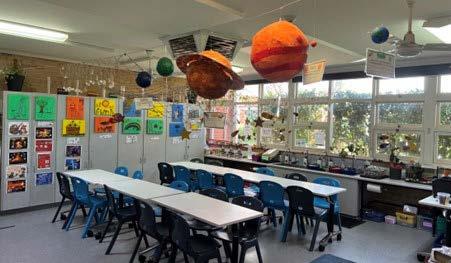 Nousha Sas
Nousha Sas
For the past two years, I have been working as a science specialist in a converted science laboratory that was originally a Maths resource room. I love the newly created position and I am grateful that the space was already fitted out with cupboards, a long sink, whiteboard, projector, microscopes, sound-absorbing ceiling panels and furniture through a grant provided by the WA government. However, the room did need quite a bit of work to be transformed into the functional learning environment it is today. Being a non-purposebuilt small space, with the prospect of hundreds of children moving through it each week as a science lab, meant I needed to think practically in regard to how all of the space would be utilised.
Storage was an issue from the outset as space was limited. Firstly, I asked for extra paid time to sort through 20 years of accumulated science resources to decide what was worth keeping and what could be cleared out. I also decided to dismantle the Primary Connections
boxes so that I could use the much needed shelving. The selected resources that I kept were then labelled and numbered. Over time, I created visual labels on the front of cupboards in order to identify where everything is located and so that other teachers can easily find resources as well. This process took time, but it has proven to be essential for programming and gathering resources for our daily investigations, as I know exactly what is available and I can easily find anything I need. This is a massive stress reliever! I also try and make time at the end of each year to go through all of the resources and move on anything that hasn’t been used, to make room for newer, more relevant purchases.
Being such a hands-on and dynamic learning environment with daily investigations, I wanted to create a space where students can move around independently and find what they need with minimal disruption. Students start each lesson by lining up in a contained area outside the lab and then enter the
PAGE 27 VOLUME 68 | DECEMBER 2022 JOURNAL OF THE SCIENCE TEACHERS’ ASSOCIATION OF WESTERN AUSTRALIA
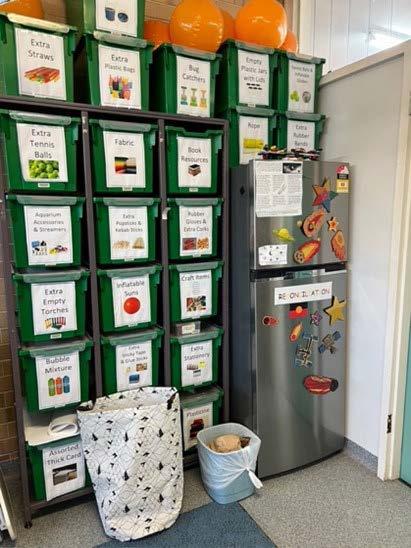
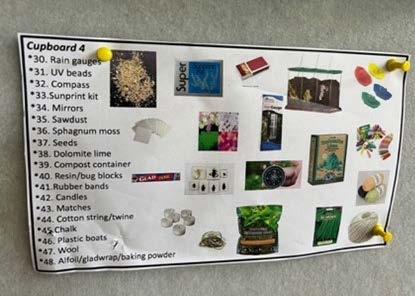
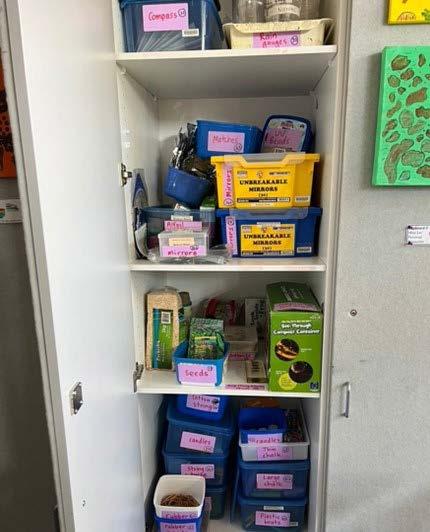
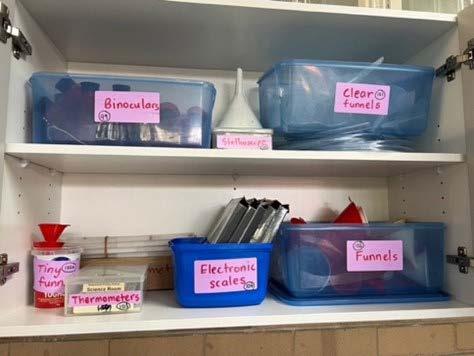
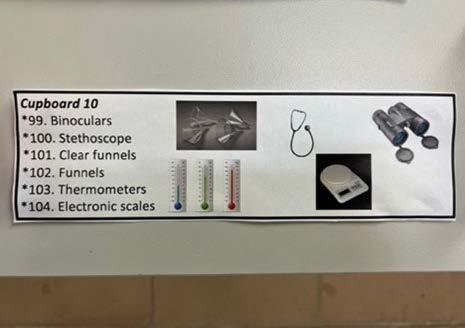
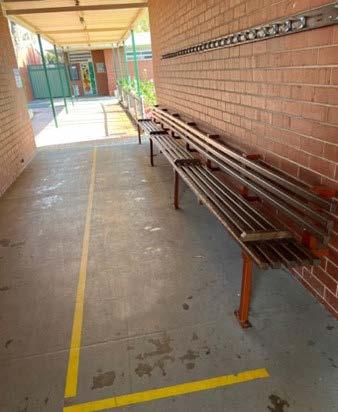
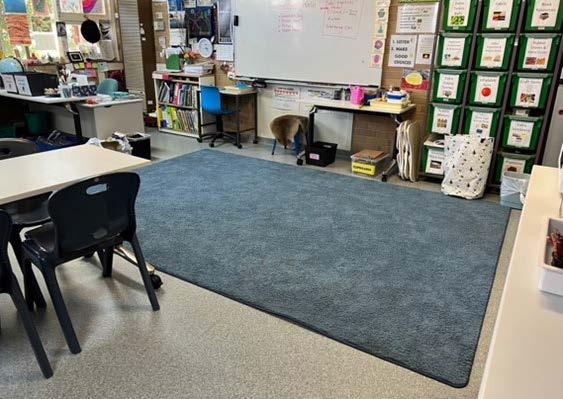
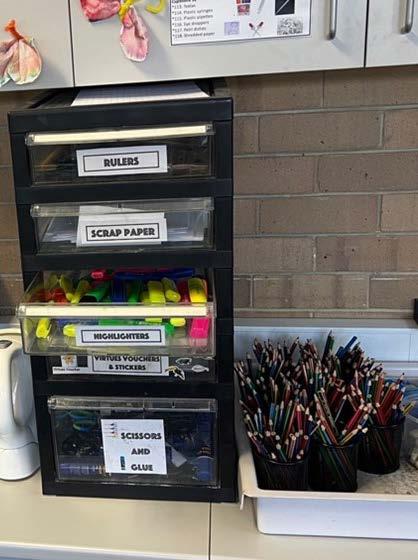
VOLUME 68 | DECEMBER 2022 JOURNAL OF THE SCIENCE TEACHERS’ ASSOCIATION OF WESTERN AUSTRALIA PAGE 28
room and sit on the mat. Students leave their pencil cases in their classrooms, as I provide all the stationery they need, in order to keep tables clear for science equipment.
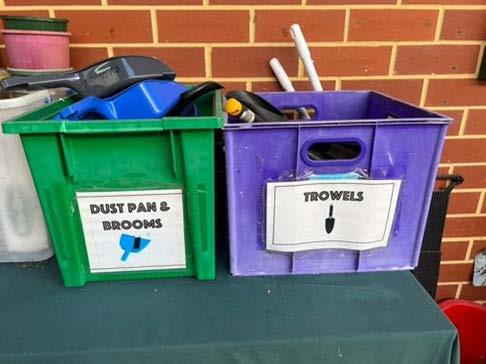
I always set up the equipment for all investigations on the same table at the front of the room, so that students can easily gather what they need each lesson and then pack away accordingly. I provide some tray tables for students to work on the floor if they choose, a class set of clipboards if we need to take papers outside, and a black box for finished worksheets when we don’t have enough time to glue work in their science workbooks. Students have direct access to their science workbooks as they are kept in the hallway in labelled class trays.
I make it clear that I expect all students to clean up their workstations after investigations, and provide dishwashing liquid, sponges, handwash, drying racks and paper towels in dispensers. If we are time poor, I fill up buckets with soapy water for students to quickly drop dirty equipment in and then later choose a few eager students to sort it out and clean up. I placed several non-slip mats near the sink to make the area safer for students.
I try and take lessons outside where appropriate and when the weather allows. I make use of nearby spaces outside and have established a courtyard garden that students can tend to with watering and weeding. I also keep some Biological Sciences resources here. I have invested in two large, recycled plastic outdoor mats for sitting on just outside the lab and I can move them into the sun or into shade when I want to.
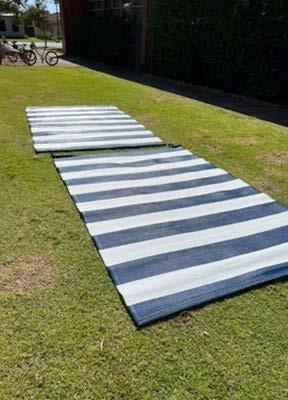
Often students complete work at different times. When students finish work early, they know there are specific areas that are always set up so they can visit to keep busy. These include, viewing the guppies in the fish tank, observing the mealworms in wheatgerm and handling the spiny leaf insects inside their cage. These animals are very low maintenance and our gardener and cleaners help me feed them over the school holidays.
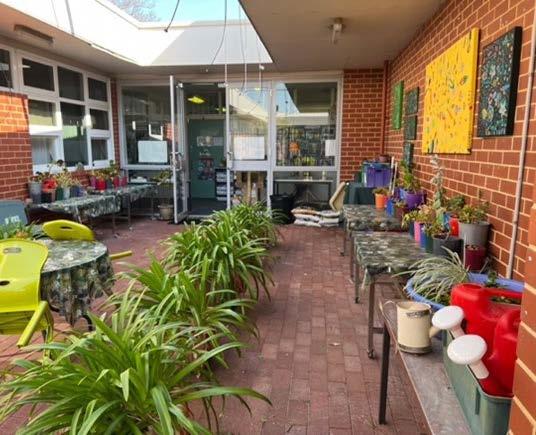
PAGE 29 VOLUME 68 | DECEMBER 2022 JOURNAL OF THE SCIENCE TEACHERS’ ASSOCIATION OF WESTERN AUSTRALIA
Students can also look at specimens under the microscopes and touch various items on the ‘touch table’ such as coral, shells, gemstones, seedpods, bark, pinecones, old nests, sea sponges, rocks and insects set in resin. I also had a floating bookshelf installed to display books that students can read once their work is complete. The books are changed each term to reflect the current strand we are exploring. All in all, the science lab is now an inspiring and functional space to both work and learn in and the students have a great sense of independence as well. It has been such a joy seeing learning come to life in this specially carved out space.
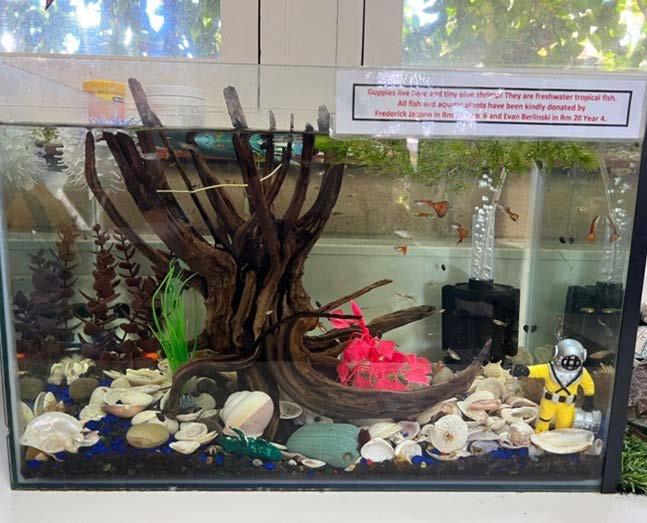
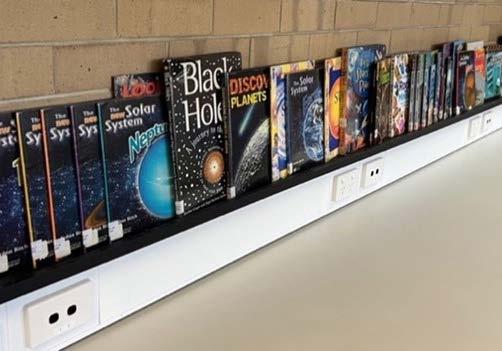
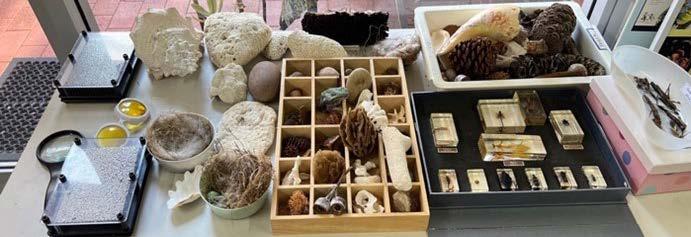
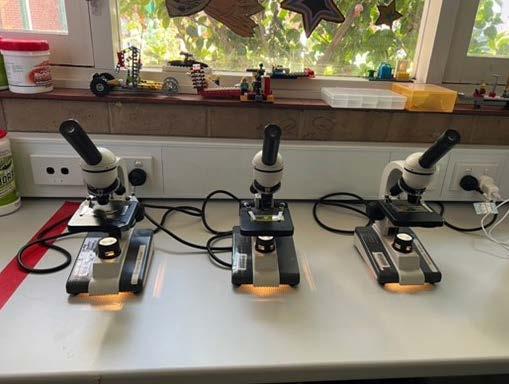
About the Author
Nousha Sas is a senior teacher with over 20 years of experience teaching in various primary schools across Australia. For the last two years, she has been enjoying working as the first science specialist appointed at Rossmoyne Primary School. Nousha has been busy spending her time establishing the lab, creating a functional learning environment, and setting up investigations.
VOLUME 68 | DECEMBER 2022 JOURNAL OF THE SCIENCE TEACHERS’ ASSOCIATION OF WESTERN AUSTRALIA PAGE 30
SCIENCE WEEK MADE EASY



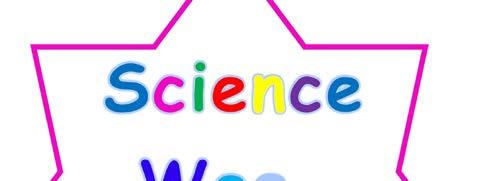


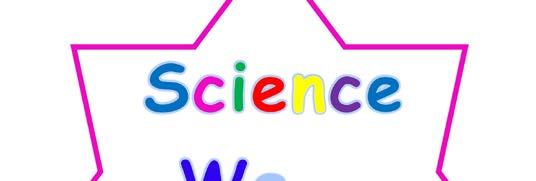

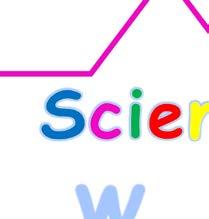


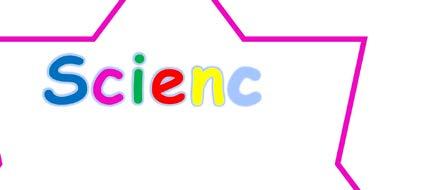







National Science Week is always a challenge for science specialists as there is often the expectation to produce new and exciting activities for students. This is a big ask as many activities and experiments are already incorporated in our planning programs as SIS investigations. As a Year 1 - 6 science teacher, we plan for two investigations per term, per topic and it meant we would have already sourced some 48 investigations.
If any of these experiments is performed during science week, then we not only lose the `inquiry process, but also need to source another topic-related task.

For this reason, we keep our class investigation and National Science Week activities separate. We put together a booklet of activities, that are organized into year levels. This means that, if used in this format, the activities could be run year after year, with each new year group. Obviously, activities can be added, adapted and removed, but by adhering to the same format, this serves to alleviate the initial stress.


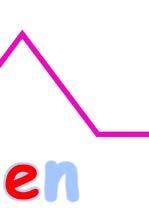
To create your own booklet of activities, please find original copies of the investigation sheets on the STAWA website under the ‘Resources’ tab, National Science Week.
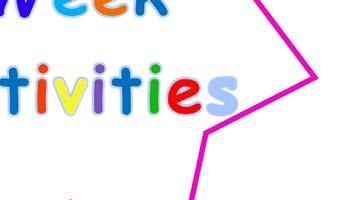
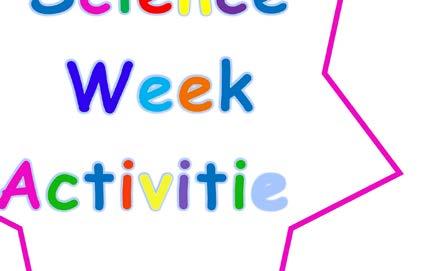

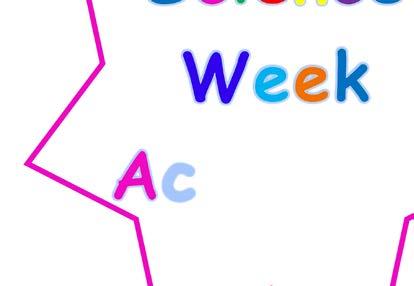

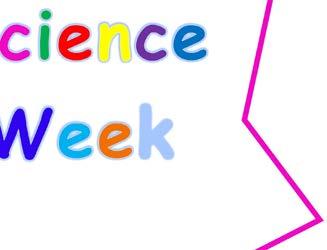

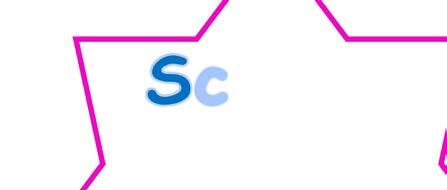

PAGE 31 VOLUME 68 | DECEMBER 2022 JOURNAL OF THE SCIENCE TEACHERS’ ASSOCIATION OF WESTERN AUSTRALIA
CONSTAWA40 ©Sharlum Science Science Week Activities
Pamela Lumsden & Charu Sharma
Pamela Lumsden Charu Sharma
Windmill
Year 1
Dancing Drawings

Science
Year 1
Australian Animal Puzzles

Year 2
Straw Rockets
Materials
Rocket templates Small, thin bore straw Large, thick bore straw Coloured pencils/textas Sticky Scissorstape 1 metre ruler














Task 1.Cut and colour the rocket templates. 2.Cut the wide diameter straw to the length of the rocket. This is the rocket cylinder. 3. Fold old one end of the straw piece over and secure with tape. Tape it to the inside of one of the rocket templates. 4.Secure both rocket templates together using tape. 5.Place the smaller straw into the larger straw. 6. Blow the rocket as far as it can go.
Year 1
Rainbow Lollies

Materials



Gently pour the warm water into the middle of the circle until it reaches the lollies.




Observe how the heat from the water dissolves the colour in the lollies to make a colourful pattern.

Science




The shells of the coloured lollies are made from sugar. When sugar is put in warm water, it dissolves. As the colours meet, they mix creating different colours.
Year 2

Rainbow Milk Materials

Food dye, various colours
Squeeze a drop of dishwashing liquid into the centre of the plate.
Add small drops of dishwashing liquid to different areas of the plate to achieve different affects.
Science The purpose of dishwashing liquid is to dissolve ‘fat’. When the dishwashing liquid is dropped on milk, it floats on top of the milk and starts to spread over the surface. As it spreads, it dissolves the fat in the milk, taking



VOLUME 68 | DECEMBER 2022 JOURNAL OF THE SCIENCE TEACHERS’ ASSOCIATION OF WESTERN AUSTRALIA PAGE 32 CONSTAWA40 ©Sharlum Science Science Week Activities CONSTAWA40 ©Sharlum Science Science Week Activities
Year 1
Materials Light weight card – white or coloured Pencil, Ruler, Scissors Masking tape/sticky tape Pin/tack Two beads One straw Paperclip Task 1.
2.
3.
4.
5.
6.
7.
CONSTAWA40 ©Sharlum Science ScienceWeekActivities
Draw two pencil lines, one from each corner of the card to the opposite corner. Make one small pinhole in each corner, just beside the line, and one hole in the centre where the lines cross.
Cut along each pencil line toward the centre. Cut halfway along each line.
Bend over each corner so that all four corner holes are on top of the centre hole.
Straighten the paper clip and attach a bead to one end. Push the paperclip through the holes.
Thread the other bead onto the paperclip behind the pinwheel.
Push the point of the paperclip firmly into the straw and secure with tape.
Test out the windmill be gently blowing on it.
Materials Shallow tray or plate,
porcelain or glass) Dry erase markers Cup of room temperature water Task 1. Use
dry
draw a simple picture or design onto a white tray or plate. 2. Gently pour the water onto the side of the dish. 3. Control the flow of water to watch your art work come to life and start floating or dancing in the water.
(white
the
erase markers to
The dry erase marker
the plate and rises
the water’s
floats and moves as if it were
This is
the special polymer in the dry erase marker ink. As this ingredient prevents the ink
attaching to the plate, the water can slip underneath. As ink is lighter than water, the drawing can float. CONSTAWA40 ©Sharlum Science ScienceWeekActivities
drawing magically detaches from
to
surface. There it
alive.
due to
from
NB: This is a Twinkl resource https://www.twinkl.com.au/resource/au-sc-142-australian-animals-split-pin-activity
Materials Animal templates Box of split pins Timer Task 1. Lay out all the animal parts. 2. Ensure the split pins are within arm’s reach. 3. Set the timer to 1 minute. 4. Start! 5. Find the correct animal parts and connect together with split pins. 6. Complete as many animals as you can within
CONSTAWA40 ©Sharlum Science ScienceWeekActivities
1 minute.
Fruit
Cup
2.
skittles and/or smarties
of warm water
White tray or white plate Task 1. Place the coloured lollies around the edge of the plate in a circle shape. or Make your initial on the white tray.
3.
CONSTAWA40 ©Sharlum Science Science Week Activities CONSTAWA40 ©Sharlum Science Science Week Activities
CONSTAWA40 ©Sharlum Science Science WeekActivities
2.
3.
Full cream milk
Dishwashing liquid Pipette/dropper Small paper plate Task 1. Pour milk into the plate, so that it is about 1cm deep.
Randomly drop various colours of food dye onto the milk.
4.
the food dye
it. This
the food dye to move and swirl,
colourful
When
is no
the fat molecules have been dissolved. CONSTAWA40 ©Sharlum Science
Bubble in a Bubble Materials Bubble mix Bubble wand Water Straw Smalltray Task 1. Pourathinlayerofbubblemixonthetray 2. Usethewandtogentlyblowalargebubbleontobubble mixonthetray. 3. Dipthestrawintothewaterandplaceitinsidethe bubbleonthetray. 4. Gentlyblowthroughthestraw,totryandgetabubble inside a bubble. 5. Howmanybubblescanyouget
the
CONSTAWA40 ©Sharlum Science Science Week Activities Year 2 Paper Strip Chromatography Materials Sheets of paper towel or coffee filters Pencil Black texta Plastic cup Pop stick Sticky tape Small cup of water Task 1. Cut a sheet of paper towel or coffee filter into a 2cm wide strip. 2. Measure 2.5cm from the bottom of the strip and gently draw a pencil line across the paper strip. This is the start point. 3. Use the texta to place a fairly large dot on the middle of the line. 4. Pour a small amount of water into the plastic cup, (less than 2.5cm, as you do not want to submerge the dot in the water) 5. Use the sticky tape to secure the top of the paper strip to the pop stick and gently roll a small portion of the top of the paper towel around it. This allows you to control the towel going into the water. 6. Lower the bottom of the paper strip into the plastic cup, so that it is just touching the water. Secure the height by balancing the pop stick on the rim of the plastic cup. 7. Observe, as the water slowly
the paper towel and
the dot. 8.
texta
the texta
with
causes
creating the
patterns.
there
more movement, all
ScienceWeekActivities Year 2
inside
originalbubble? Science Abubblehasthreelayers,athinlayerofwatersandwiched betweentwolayersofsoapmolecules.Thesurfaceofthe bubblehas‘surfacetension’whichcanbebroken,or‘pop’ whenthebubbletouchessomethingdry.Thestrawmustbe wet to allow a bubble to be blown inside another bubble. As thesmallerbubbleisblown,theoutsidelayersofthebigger bubble stretch to accommodate the additional air volume of the smaller bubble.
creeps up
reaches
Once the
dot is reached, all the colours making up the original colour of
will be seen separately.
Year 3
Origami Jumping Frog
Materials
You tube video clip – for example: Kids easy origami - How to make a jumping frog ver.1.



Thick paper or Origami paper, (various shades of green)

Make a frog obstacle course, (race track, plastic horse jumps, water jumps etc.
Task 1. Follow the laminated instructions to make an origami frog. 2. Place frogs on your obstacle course and race them and jump them. 3. Assign points for different challenges. Challenge a friend - Race your frogs, whose frog can jump the furthest, whose frog can jump the highest?
Year 3
Coloured Glasses
Materials
Glasses template on white, light weight card
Scissors
Sticky tape and/or glue stick Different colours of cellophane Coloured pens/textas
Permanent marker pen/Sharpie
Task Make a pair of glasses with interchangeable coloured lenses.


1. Cut out glasses frame, temples and lens template. Ensure to cut holes in the lenses.
2. Decorate the glasses frame and temples with coloured pens. 3. Use glue or sticky tape to attach the temples to the frame. 4. Carefully fold the bottom lenses up behind the top lens. (It may help to use a ruler and pencil to score an indentation on the dotted fold line to help fold it).
5. Lay the cardboard lenses on the cellophane colour of choice. Make the cellophane lens slightly larger than the template by drawing about 5mm around the perimeter of the template.
6. Place different coloured cellophane lenses in the glasses and secure by folding the tab over the top of the glasses.
7. Cut out more cellophane lenses and interchange them.
Salt Painting
the paper plate the correct way up.
Use the glue to make a simple design on the plate.



Place the plate above the tray and sprinkle a generous amount of salt on the glue. 4. Once the glue has dried, use the paintbrush to dab different colours of paint onto the salt and watch the colour travel along the design.
Science
The water in the ‘water-based’ paint or food dye, is absorbed by the salt, allowing the colour to stain the salt. The volume of water, determines how far the colour will travel; the small volume of water runs along the salt until it is completely absorbed.
Year 3
To add more colour, additional strokes of ‘water-based’ colour or food dye is added.
Speed Boat Races
Materials
Shallow rectangular tray
Full cream milk
Plastic bread clip or small piece of plastic-coated cardboard
Scissors or nail clippers Permanent markers/Sharpies Dishwashing liquid

Task Race against your classmates


1. Use the scissors or nail clippers to either make a small speedboat with the plastic-coated cardboard or re-shape the front of the bread clip to make it more aerodynamic.

2. Uniquely identify your speed boat with your initials or some additional colour.


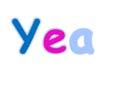

3. Pour some milk into the tray to cover the bottom, (it does not need to be deep).
4. Place/‘float’ the speed boat at the starting point, (one end of the tray).
5. Draw up some dishwashing liquid into the pipette/dropper.


6. On the starters signal, place a drop of dishwashing liquid into the hole/space at the back of the speed boat.
7. Keep adding detergent to get your speedboat over the finish line.
Juggling Balls Materials
Year 4
Three balloons, per ball, (different colours) Rice, (about ½ cup each ball) Small plastic soft drink bottle


Scissors Task
Use the funnel to pour ½ cup of rice into a small plastic drink bottle.
Inflate the balloon to about half its size. Twist and hold on to the neck of the balloon.
Stretch the neck of the balloon over the rice filled bottle.
Turn the bottle upside down, to allow the rice to flow into the balloon. 5. Remove the balloon from the bottle and gently let it deflate while holding onto it tightly.
6. Cut the neck off the balloon. Allow enough material to sticky tape the hole shut.
7. Cut the neck off a second balloon and stretch it over the first balloon, ensuring the hole of the first balloon is completely covered.
8. Take the third balloon and cut small holes in it. Cut the neck off and again stretch it over the second balloon, to produce a spotty patterned juggling ball.

Year 4
Mexican Jumping Bean Materials
Aluminium foil, cut into rectangles of 7cm x 12 cm Marbles
Square edged plastic container with lid Task 1. Cut a rectangular piece of aluminium foil 7cm x 12cm. 2. Make a 7cm long tube with the foil, by either wrapping around your finger or a thick marker pen. The tube should be a little wider than the marble.
3. Place the marble in the tube. Seal both ends of the tube by tightly twisting and squashing the aluminium foil together. The marble should be able to roll from one end of the tube to the other.
4. Put the marble/tube into the square, plastic container and shake from side to side. This will round off the ends of the foil. 5. After a several ‘hits’ against the edges of the container, the foil will take the shape of a round ended ‘bean’. 6. Now, hold the box at a slight angle and watch how the ‘bean’ moves.
Science
When the ‘bean’ is held at an angle, the marble rolls to the sealed end of the foil. Because the marble is heavier than the foil, the foil flips over and the marble again rolls to the other end of the sealed foil, thus the foil/marble bean continuously flips over.

PAGE 33 VOLUME 68 | DECEMBER 2022 JOURNAL OF THE SCIENCE TEACHERS’ ASSOCIATION OF WESTERN AUSTRALIA CONSTAWA40 ©Sharlum Science Science Week Activities
©Sharlum
CONSTAWA40
Science ScienceWeekActivities
Gary Easy Origami https://www.youtube.com/watch?v=1kZjq8f8Mpo
©Sharlum Science Science Week Activities
CONSTAWA40
Year 3
Thick cardboard/paper plate School grade glue, (in squeezy bottles) Liquid water colour paints or diluted food dye Paintbrush Salt Large tray to catch
salt
Materials
sprinkled
Task 1. Place
2.
3.
©Sharlum
CONSTAWA40
Science ScienceWeekActivities
CONSTAWA40 ©Sharlum Science ScienceWeekActivities
Pipette/dropper
CONSTAWA40 ©Sharlum Science Science Week Activities
©Sharlum Science ScienceWeekActivities
CONSTAWA40
Funnel
1.
2.
3.
4.
CONSTAWA40 ©Sharlum Science ScienceWeekActivities
CONSTAWA40 ©Sharlum Science Science Week Activities Year 4 Balloon Race Materials Fishing line Straw Masking tape/sticky tape Balloon Two objects of the same height to tie fishing line to, (pillar/pole) Task 1.Tie one end of the fishing line securely to one of the pillars/poles. Make sure it is securely fashioned. 2.Take the straw and thread it through the fishing line. 3.Tie the other end of the fishing line to the other pole, making sure the fishing line is taught. 4.Place two pieces of tape on the straw, near the middle. (If the tape is near the ends of the straw, the line will bend when you attach the balloon and will not move as quickly. 5.Inflate the balloon and hold the end so the air can’t escape. Use the two pieces of tape to secure the balloon to the straw. 6 Move the straw and balloon to one end of the fishing line. 7. Then – Let go! 8. Race the balloons with your friends - Whose balloon flies the fastest? CONSTAWA40 ©Sharlum Science ScienceWeekActivities Year 4 Bead Obstacle Course Materials Paper plates Maze template, if required ‘Start’ and ‘Finish’ theme – clipart, stickers, drawings (e.g., dog and bone, koala and eucalyptus leaves) Straws Glue Scissors Small beads or aluminium foil rolled into a small ball Task 1. Design a maze with at least 6 turns. Give it your best try. If you require help, look at or use, the example template provided. 2. Cut up the straws, arrange and sticky tape them firmly to the plate. 3. Glue your chosen animal to the ‘start point’ of the maze and the animal’s food choice to the ‘end point’ of the maze. 4. Place the marble at the front of the maze and guide it through the maze to reach the end point. 5. Swap mazes with a friend and challenge each other to a race, or time each other with different mazes.
Year 5
Bubble Trampoline
Year 5
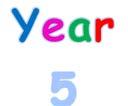
Scissor Grabber Materials


Thick cardboard or 3mm thick corflute Scissors, Ruler, Pencil Textas fordecorating Pin








Experiment with different sizes and shapes of bubbles to see which ones last the longest.

Year 6 Spaghetti Bridge
Design a free-standing bridge that allows a golf ball to travel over it without the bridge collapsing.

bridge must be at least 20cm long.
The bridge must be free standing, so that it can lifted onto the ‘riverbanks’ and balance on each side.
The bridge must resemble one of the truss bridges in the examples.
The ‘river banks’ must be at least 20cm high.
stacks of books or boxes.
CONSTAWA40
©Sharlum Science ScienceWeekActivities

Paper and pencil
Spare
in
plastic cups in a given time, or see whose grabber can pick up 4.
volumes of water. 5.

Morse code: SOS, (Save Our Souls).


3.
the heaviest weight – add water to plastic cups using varying Use
Morse along with
Henry and Alfred
The




golf ball must be gently rolled over the bridge and not thrown at speed. 6.The bridge should support the weight and traction of the golf ball.
6

CONSTAWA40 ©Sharlum Science ScienceWeekActivities Year

Materials Cardboard template to cut around or students to use their own hands Light weight, coloured card, A4 5 different colours of string/wool One large straw – cut to 6cm Four small straws, cut as required for wrist, palm and fingers Task Make a bionic hand with moving fingers and thumb. 1.Take a sheet of coloured card and trace around the template provided or draw around your hand. 2. Cut out the traced hand out. 3. Mark the finger joints on the cut out, drawing straight or curved lines across the joints. 4. Fold the fingers at the lines. 5. Cut smaller straws to size (leave a little gap between the lines to facilitate in threading the string/wool). 6. Tape straw pieces to the hand. 7. Use sticky tape to attach string/wool to the back of one finger and then bring it over and thread it through the straw pieces. 8. Repeat this with each finger and thumb. Each finger/thumb will have a length of string of its own. 9. Thread all five pieces of string through the bigger straw. 10. Practice pulling the string/wool to move the fingers.

VOLUME 68 | DECEMBER 2022 JOURNAL OF THE SCIENCE TEACHERS’ ASSOCIATION OF WESTERN AUSTRALIA PAGE 34 CONSTAWA40 ©Sharlum Science Science Week Activities CONSTAWA40 ©Sharlum Science Science Week Activities Year 5 Ping
Ball Run Materials Cardboard base Paper, maximum 30 sheets Masking tape and/or Sticky tape Pencil Ruler Scissors Ping pong ball Stopwatch Task Design and create a ping pong ball run which takes the ping pong ball at least 10 seconds to roll from start to finish. 1. Use the supplies provided to make the run. 2. You will have to test run many angles, heights and distances before you reach your final design. Paper Ball Run: 2022 Fluor Engineering Challenge https://www.youtube.com/watch?v=fAt5B29lzqI CONSTAWA40 ©Sharlum Science ScienceWeekActivities Year 5 Catapult – Marshmallow launcher! Materials 6 pop sticks Small wooden spoon 4 elastic bands Marshmallows Task How many marshmallows can you land in the container? 1.Join the 5 pop sticks together with two elastic bands. 2.Use an elastic band to connect another pop stick to the ‘handle’ end of the wooden spoon. 3.Separate the spoon and the pop stick and place the stack of pop sticks in between them. 4.Wrap an elastic band around all of the pop sticks to hold the catapult together. 5.Place the mini marshmallow on the spoon, push down on the spoon and release to launch the catapult. CONSTAWA40 ©Sharlum Science Science Week Activities
Pong
Bubble mix Pipe cleaners
String,
Straws
School tray Task
1.
2.
3.
4.
5.
Materials
to make wands
72cm
x 2
Bounce bubbles on the trampoline
Make the boundary of the trampoline by threading the string through the two straws and tying string together.
Slide the knot up into one of the straws and arrange as above.
Use the pipe cleaners to make different sizes and shapes of wands.
Pour bubble mix into ‘school tray’.
One student immerses the ‘trampoline’ into the bubble mix and lifts it out slowly to ensure a thin film of mixture is suspended in the frame. 6.Another student dips their pipe cleaner wand into the bubble mix and gently blows the bubble onto the trampoline. 7.Bounce the bubble up and down on the ‘trampoline’ as many times as you can before it pops! 8.
Split pins, (19mm) Glue Masking tape and/or Sticky tape Various materials tocover grabber ‘jaws’ - toaid grip.
e.g., elastic bands, rubber, cloth material etc Task Whose grabber is the best? 1.Cut the cardboard or corflute into 6 strips, (17cm x 3.5cm).
2. Cut 2 smaller strips for the‘jaws’,(approx. 7cm x 3cm). CONSTAWA40 ©Sharlum Science Science Week Activities
3. Use a pin to poke 3 evenly spaced holes along the strips. CONSTAWA40 ©Sharlum Science Science Week Activities
One hole in the middleand one at either end. Each strip Materials One packet of spaghetti Packet of mini marshmallows Elastic bands Golf ball Books or boxes to create height and depict ‘river banks’. Task
needsthe three holes in the identical spot. Lay the strips Rules 1.The
on top ofeach other to align holes. 4. Arrange strips as shown above and attach together with 2.
split pins. 5. Improve the grip of the ‘jaws’ by attaching different materials, serrating the edges, etc. 6. Challenge your friend to see who can pick up the most 3.
©Sharlum Science ScienceWeekActivities
Science Engineers build bridges! However, there are many different branches of engineering. Civil engineers are responsible for design and construction. They work with mechanical engineers and material engineers to design the most stable structures.
CONSTAWA40
Year 6
Morse Code - Snap Circuits
Materials Snap Circuit kits Morse code sheet, laminated
Batteries
fuses Task Use the ‘Snap Circuit’ to send the most recognised message
1.
Read the instruction booklet to determine how to use the buzzer.
2.
Refer to the laminated sheet, displaying the dots and dashes of Morse code and ‘buzz’ the letters, SOS to a partner.
In pairs, try send and receive short messages using the dots and dashes code. You will need a pencil and paper to write down the dots and dashes, before translating them into letters, words and ultimately a sentence.
Egg Drop Challenge Materials Raweggs Bigblackgarbagebags-underchallengearea Various materials o Bubblewrap,cottonballs,plasticfoodcontainers, string,tape,straws,newspaper,plasticbags,balloons, eggcrates Timer Task Create a container that will safely deposit a raw egg onto the ground when it is dropped from a height. Rules 1.Youcanonlyusethematerialsprovided. 2.Youcannotuseastore-boughtbag. 3.Theeggcannotjustbesurroundedbyballoons. 4.Notwodesignsshouldbethesame. 5.Youhave5minutestodiscussthedesign,10minutesto createthedesignand5minutestotest. CONSTAWA40 ©Sharlum Science ScienceWeekActivities
Science In 1836, Samuel
Joseph
Vail developed the electrical telegraph – the first digital communications system. Samuel Morse applied a dot, dash code to each letter of the alphabet and this led to a new way of communicating. The telegraph sends electrical signals down a wire transforming the signals into sound energy. Morse code was the first message system that could be sent efficiently and quickly over long distances.
Year 6 Bionic Hand
For more information, you may contact Pamela or Charu at: Pamela.lumsden@education.wa.edu.au Charu.sharma@education.wa.edu.au
About the Authors
Pamela Lumsden started her career as a medical scientist, working in pathology laboratories analysing tissue and body fluids. After 20 years, she changed profession and has now worked as a science specialist, teaching Year 1 to Year 6, for the last eight years. Pamela currently works at Bletchley Park Primary School.
Charu Sharma is a specialist science teacher at West Leeming Primary School, inspiring students to develop scientific interest, skills, knowledge and scientific thinking to adapt to a world of continuous change. Charu has a bachelor’s degree in commerce and a master’s in business administration. Very early in her career, she discovered her true passion for handson Science teaching. Since joining STAWA Primary Committee in 2019, she has worked in various schools doing TDS Science role and Lead Teacher for ‘Teachers Can Code’ program. She also pioneered STEM Girls club at Rostrata Primary School and has been actively sharing her passion for science teaching and learning with like-minded professionals and students.
PAGE 35 VOLUME 68 | DECEMBER 2022 JOURNAL OF THE SCIENCE TEACHERS’ ASSOCIATION OF WESTERN AUSTRALIA
STAWA MEMBERSHIP
Become a STAWA Member or Renew Your Membership by visiting; http://stawa.net/teachers/membership/ or by calling the STAWA office on (08) 9244 1987.
STAWA SERVICES AND SUPPORT
Catalist and Primary Science Chat STAWA’s lists server (All teachers)
Catalist reaches over 800 Science Educators and together with Primary Science Chat and social media such as twitter (@SciTeachersWA) are used to share information, ask questions and discuss current issues. To subscribe click here or follow the link from our website homepage
Teachers’ Survival Kit (Members Only)
Found on the web at www.stawa.net, For Teachers. Members can upload and downloaded resources (exams, tests, course outlines, etc).
Australian Science Teachers’ Association, ASTA, Affiliation
All full fee paying members enjoy the benefits of affiliated membership to the national body.
Members receive the following publications 1.
Teaching Science (ASTA journal) – Four issues
PRISCI PIN-UPS (Primary Science) – Four issues
SCIOS (STAWA online journal) – Three issues. E-Newsletters and Print Newsletters
National Science Week Activity Book (ASTA publication)
Professional Development & Conference Programs
Science Talent Search Booklet
Science iQ online science quizzes Information
Members receive discounts on STAWA Professional Development Workshops and Conferences, and STAWA resources and publications.
Professional support Including information and professional advice on employment and teaching, curriculum, government policy, science equipment and professional development.
STAWA offers teaching and learning enrichment opportunities such as, Physics Day @ Adventure World, Science Talent Search and ScienceIQ Online Quizzes.
Professional recognition of the achievements and service of science teachers through annual awards such as the de Laeter Medal, the STAWA Primary Science Award and Jeff Cahill Early Career Teacher Award. STAWA also recognizes student achievements through Science Talent Search and the ScienceIQ Online Quizzes.
STAWA provides an independent voice and with representation on many bodies and committees can express the needs and concerns of its members and help to shape the profession.
Call for Nominations for STAWA Life Membership
STAWA Council calls for nominations for Life Membership. Each nomination for Life Membership is considered on its individual merits. Nomination must be forwarded to the President of the Association, in writing, by 11th August, accompanied by written evidence supporting the case for Life membership. (email: admin@stawa.net or mail: STAWA President, PO Box 7310, Karawara, WA, 6152).
VOLUME 68 | DECEMBER 2022 JOURNAL OF THE SCIENCE TEACHERS’ ASSOCIATION OF WESTERN AUSTRALIA PAGE 36
3. 4. 5.
7.
2.
6.
8.
CAN YOU CONTRIBUTE?
YES, of course you can. So can lab technicians and students... your Year 7 or Year 8 class could write a half page article with a photo that we would love to publish.
We are keen to increase the number and variety of types of articles published in SCIOS. SO if the answer is YES to any of the following questions, we want to hear from you.
Have you recently conducted a new experiment that worked really well?
Is there a great demonstration that always gets your students’ attention?
Have you tried a new teaching technique that was fun?
Do you have some helpful hints for new teachers (and not-so-new ones)?
Are there some safety hints and tips that you’d like to pass on?
Have you used computers or some other technology really effectively?
What successes have your students had in science?
Are your students involved in science project outside of school?
Anything else science-related you would like to share with others?
Email your contributions to info@stawa.net
GUIDELINES FOR AUTHORS
These notes are a brief guide to contributors. Contributors should also refer to recent issues of the Journal. Refereed articles are peer reviewed by the Editor and anonymously by at least two reviewers.
Feature Articles
Feature articles should not normally exceed 3000 words plus figures, tables and references. Short, concisely written articles are very welcome. Please use headings and sub-headings to give your article structure. WE also welcome any other type if contribution. Reviewed articles are subject to peer review.
HOW TO CONTRIBUTE
Send the following to the Editor
If you cannot send your contribution in the following recommended form, please send it to the Editor in any reasonable form.
1. 2. 3.
Please send your document as a word file.
Photographs and other images (e.g. diagrams) should be sent as separate files.
Photographs often increase the clarity and interest level of your work. Send your photographs as .tiff or highest quality .jpeg files with a resolution of at least 300 dots per inch (dpi). Note to teachers: Parent permission (signed permission slip) must be obtained for any photographs to be included in SCIOS
4.
Copyright clearance for any part of your contribution that is copyright of a third party needs to be obtained in writing (email acceptable).
Innovations in the classroom
The editorial; board members are keen to increase the number of articles on this topic. We are always keen to review your ideas about experiments, demonstrations, teaching techniques, hints, safety notes, computer applications and anything else that could help classroom science teachers, especially beginning teachers.
Reference style
SCIOS reference style is based on the most recent edition of the Publication Manual of the American Psychological Association.
Copyright
No other publisher should have already published our manuscript, nor should you submit it for publication elsewhere. If SCIOS publishes your manuscript then your text and graphics will become copyright of STAWA. STAWA will, however, allow you to use the contents of your paper for most reasonable non-commercial purposes.
Contact John Clarke, STAWA email john@stawa.net
PAGE 37 VOLUME 68 | DECEMBER 2022 JOURNAL OF THE SCIENCE TEACHERS’ ASSOCIATION OF WESTERN AUSTRALIA
• • • • • • • • •



















































 Nousha Sas
Nousha Sas


























































































